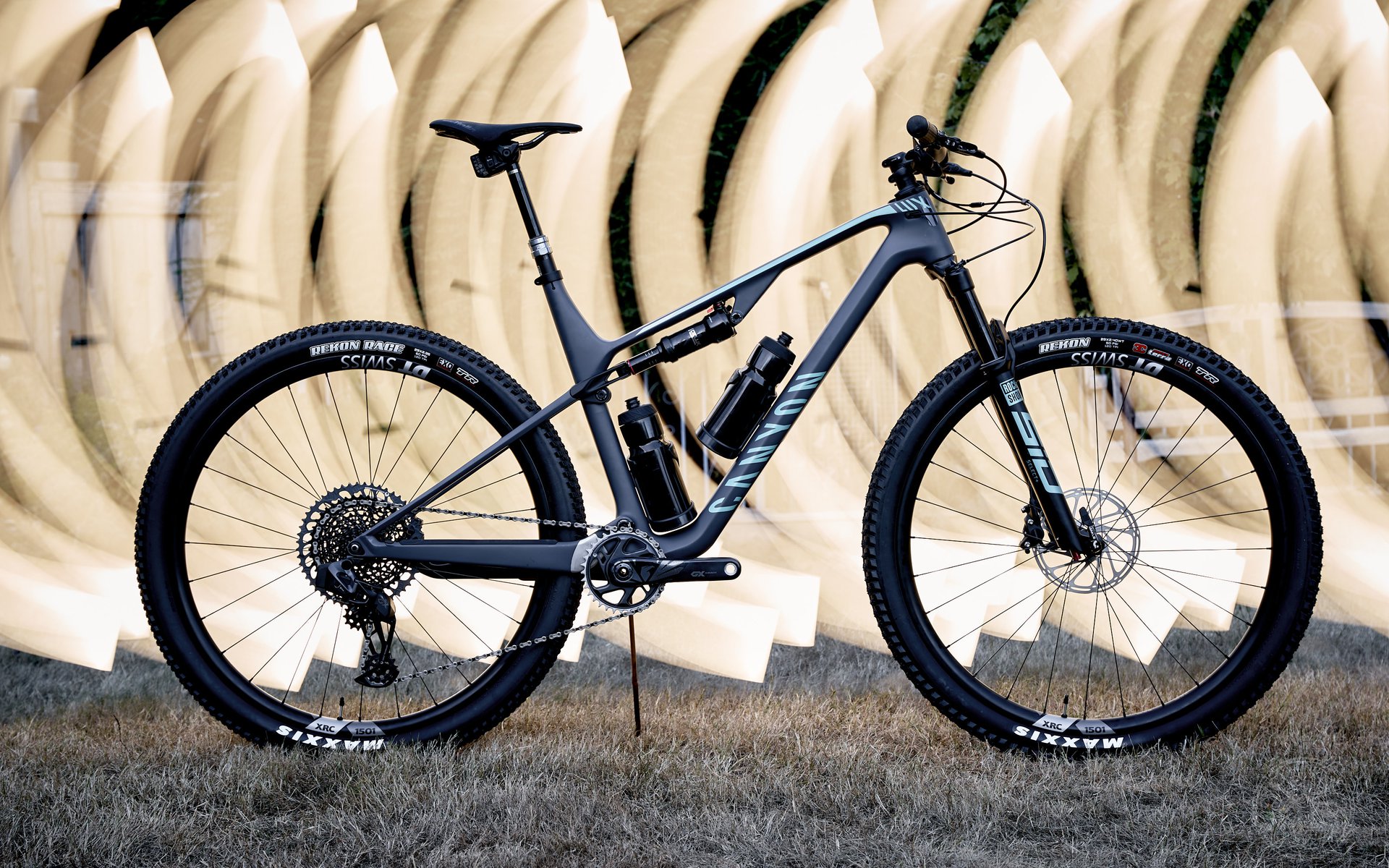
REVIEW
2022 Canyon Lux, Trail Bike?
What Lux Is
I enjoyed most of my time with the Canyon Lux Trail and I have many positive things to say. Actually, in terms of the rear suspension, it's exactly what I'd be looking for in a personal full suspension bike. That's both considering the amount of travel and the performance. I'd even pair that 110mm of efficient rear travel with a 120mm fork just as Canyon has done.
On the other hand, I think this bike suffers from being an evolutionary step. It's a next-generation World Cup XC bike dressed up in the marketing of a trail bike. It's a BC Bike Race (BCBR) bike that's good on the North Shore at the time of year that the BCBR circus would normally roll through town but less so for the other 3/4 of a year of Raincouver riding. And, unlike other machines with great potential, a few component swaps aren't enough to get the fun factor to an acceptable level on local terrain, year-round.
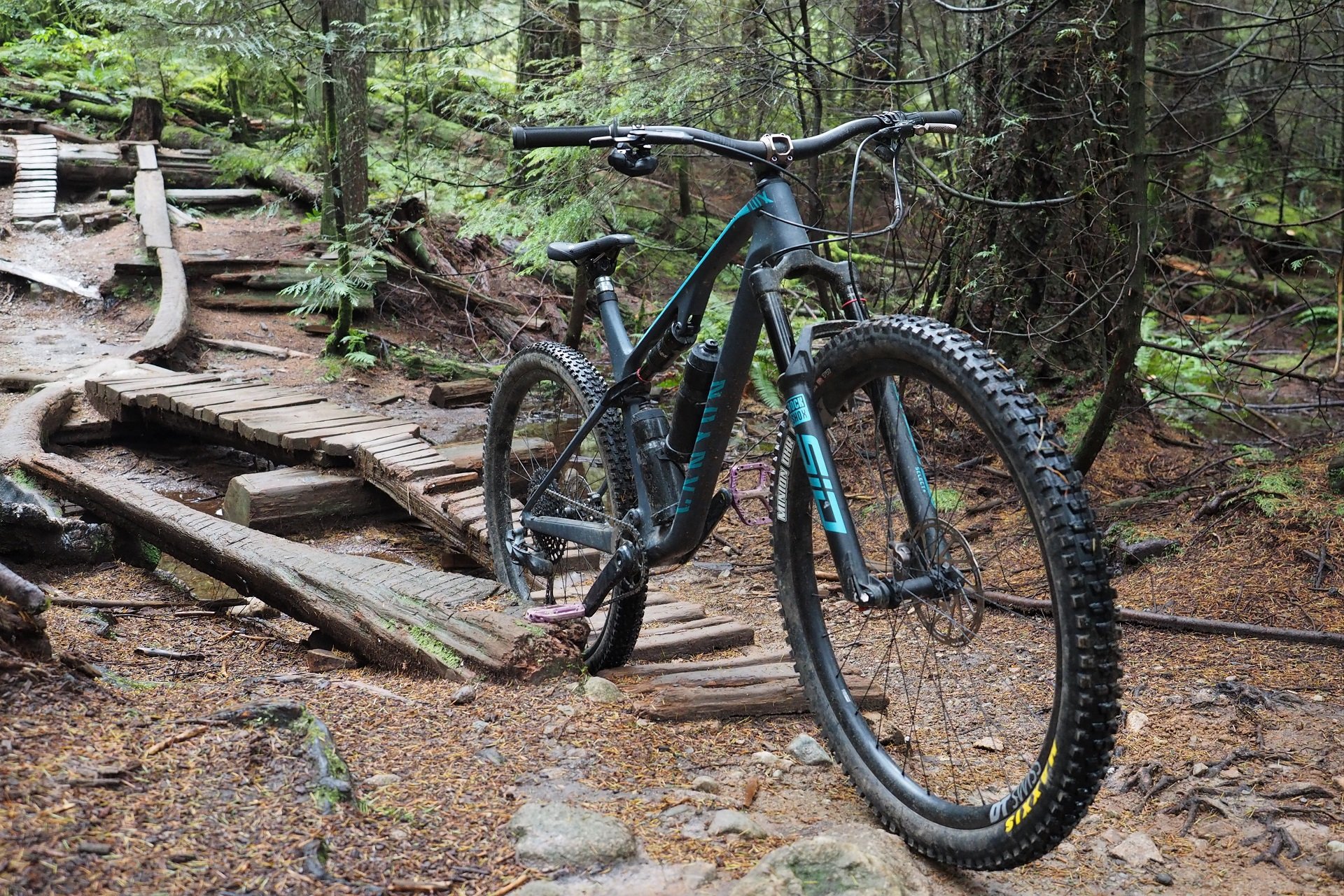
The rear suspension on the Lux Trail frame is the highlight of this test. The 110mm travel isn't exactly comfortable tearing down trails but the performance is exactly what I'm looking for in a shorter travel bike. (Photo: AM)
This bike efficiently makes traction up wet greasy roots and in loose terrain and it was dreamy to climb. The 28lbs, with pedals and a DHR2 front tire, seems on point and despite having ridden bikes in lighter weight classes, I've never ridden a bike that floated up smooth or technical trails so pleasantly.
I overextended the combined descending capabilities of the Lux Trail and myself on our first couple of rides. Badly. Keeping in mind, it was on trails I regularly ride my rigid bike down. The result was that I quickly recognized that I was going to hate doing this review if I didn't limit the terrain I was taking the LT down. And this was in the part of the year where traction is a given. I didn't want to go too easy on the bike, or myself, so I limited it to local BCXC trails that have featured in past editions of the BC Bike Race and trails of a similar caliber. The BCBR alumnus included Severed Dick and Forever After on Mt Seymour and Pipeline on Mt Fromme.
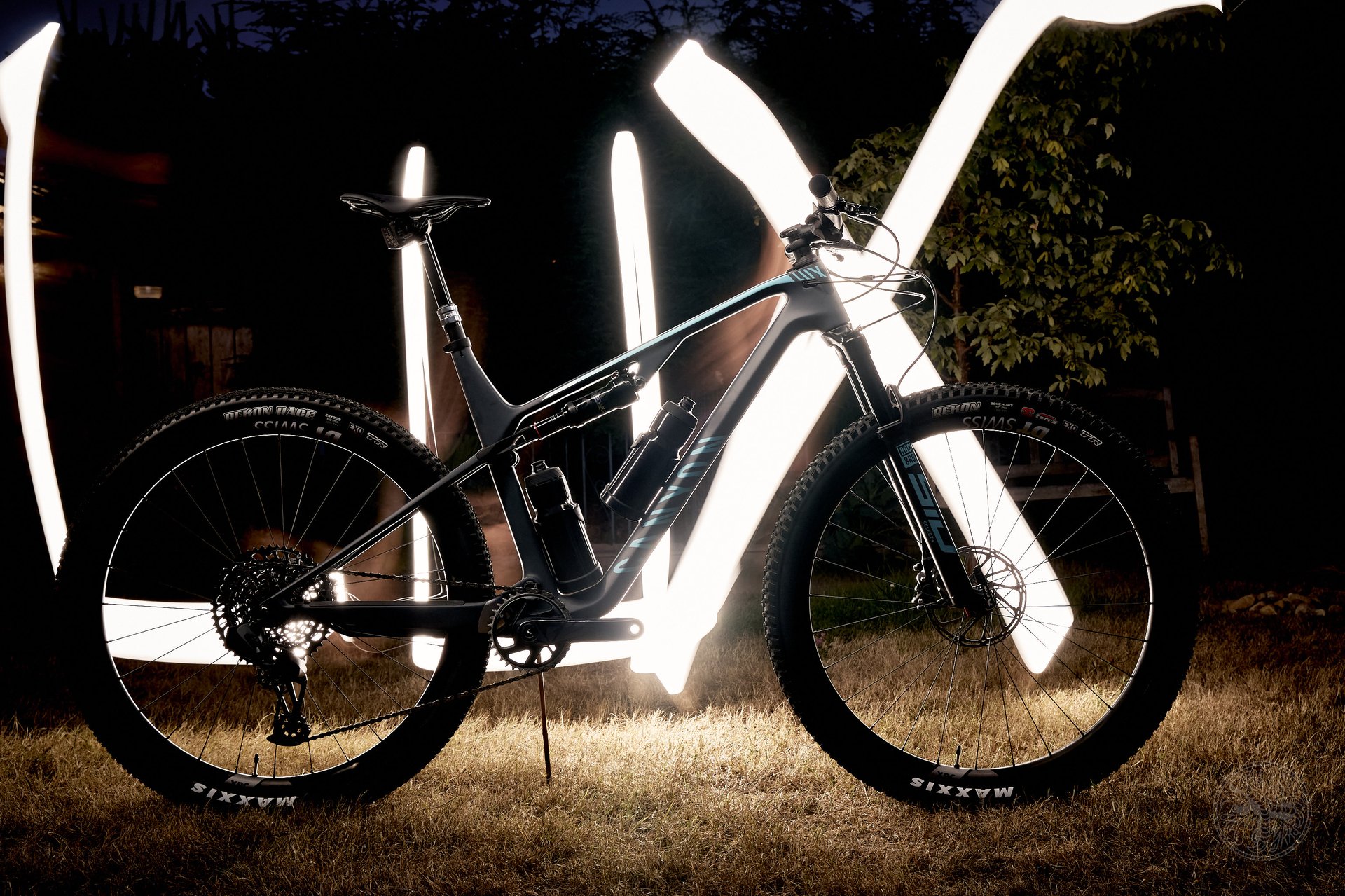
I love the lines of the frame. I think Canyon did a beauty job incorporating the rear shock and two usable in-frame water bottles.
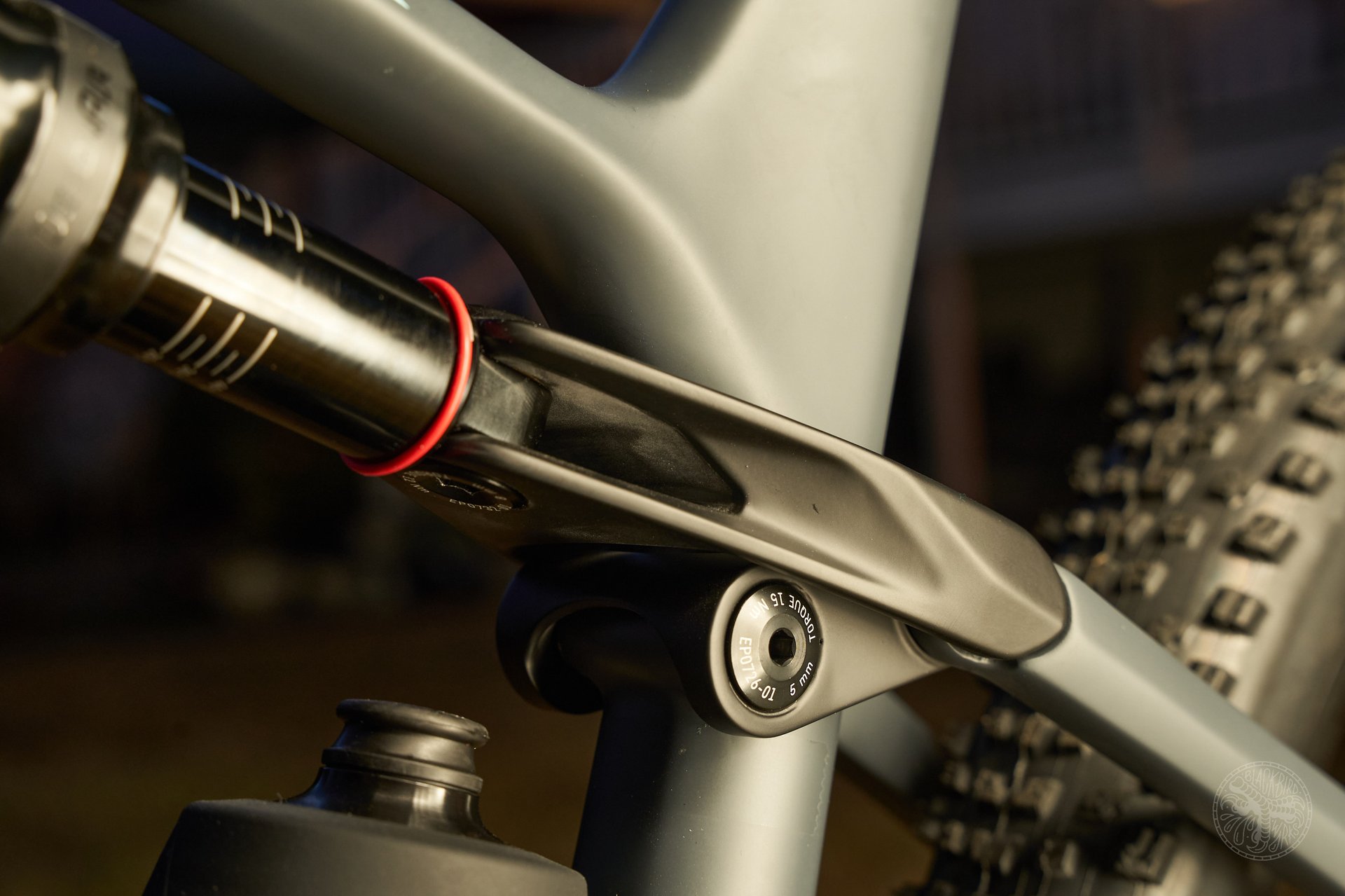
The integration of the seat-stay driven linkage and looped carbon flex stays is second to none. Clean, simple, and seamless.
On the prescribed terrain, and with some key upgrades to the stock build, I was having great fun on the Lux until the weather changed. Fall brings colder temperatures and significantly more precipitation and with it greasier roots and rocks, less responsive suspension, and less trustworthiness from harder compound tires. Every ride that was previously on the happy side of the fun line had transitioned into a battle for survival and no amount of component swaps would have had me choosing to ride the Lux Trail for adventures beyond gravel rides and the odd truly-XC pedal.
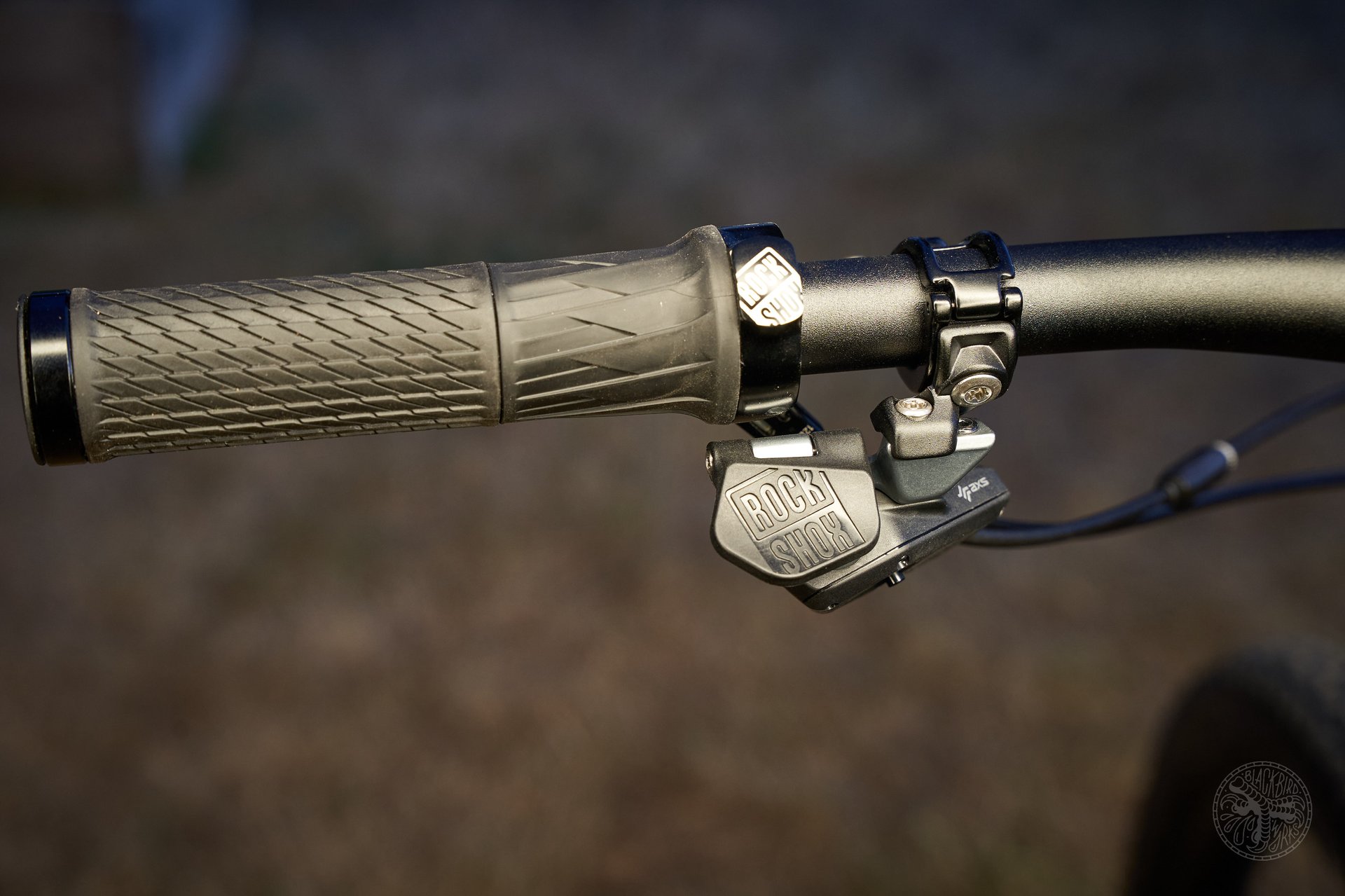
If in doubt, lock it out! Kidding, I only used the remote lock-out on pavement and even then it's an aesthetic I'd prefer to go without.
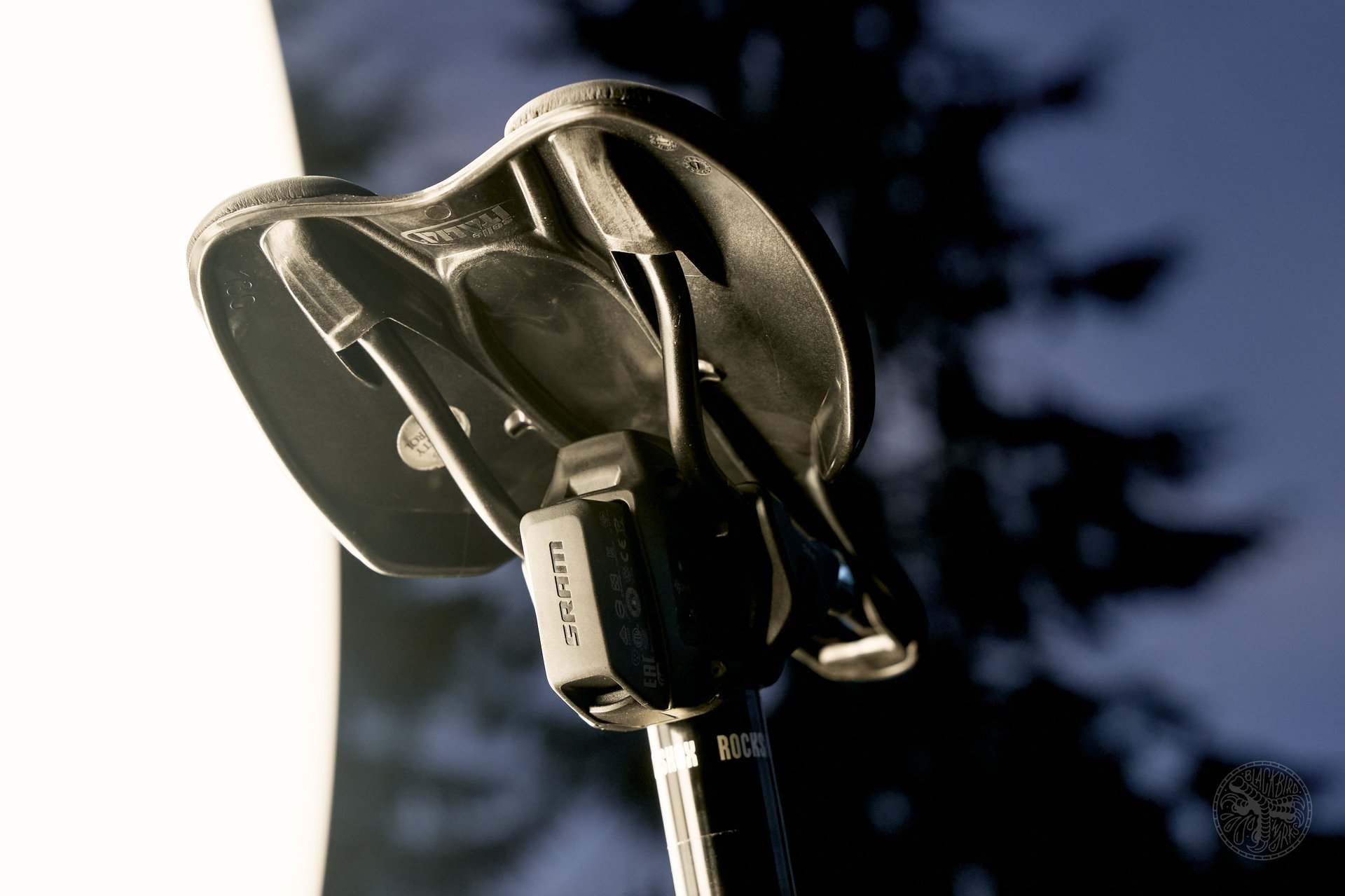
If in fright, drop that height! The AXS Reverb dropper post is excellent. I do wish the bike came with or at least I could physically run a 170mm dropper.
Right-Sizing
By the numbers, the Lux Trail runs moderately-long 435mm chainstays across all sizes. The headtube angle (HTA) is 67.5° and relatively long reaches (480mm for this large) combined with XC-standard 74.5° seat tube angles make for roomy cockpits. Canyon firmly places me on a medium in their size chart but I chose the large because the rider position so closely matches my daily driver. My own trail bike has a significantly slacker HTA and longer chainstays that combine to deliver a cruiser-length wheelbase compared to the corvette-sized Canyon. I'll be surprised if anyone looking at this bike for trail duty - versus racing around a technical-but-groomed modern racecourse - is going to argue with me that a 66° or even a 65° head tube angle wouldn't be better suited. More stability = better.
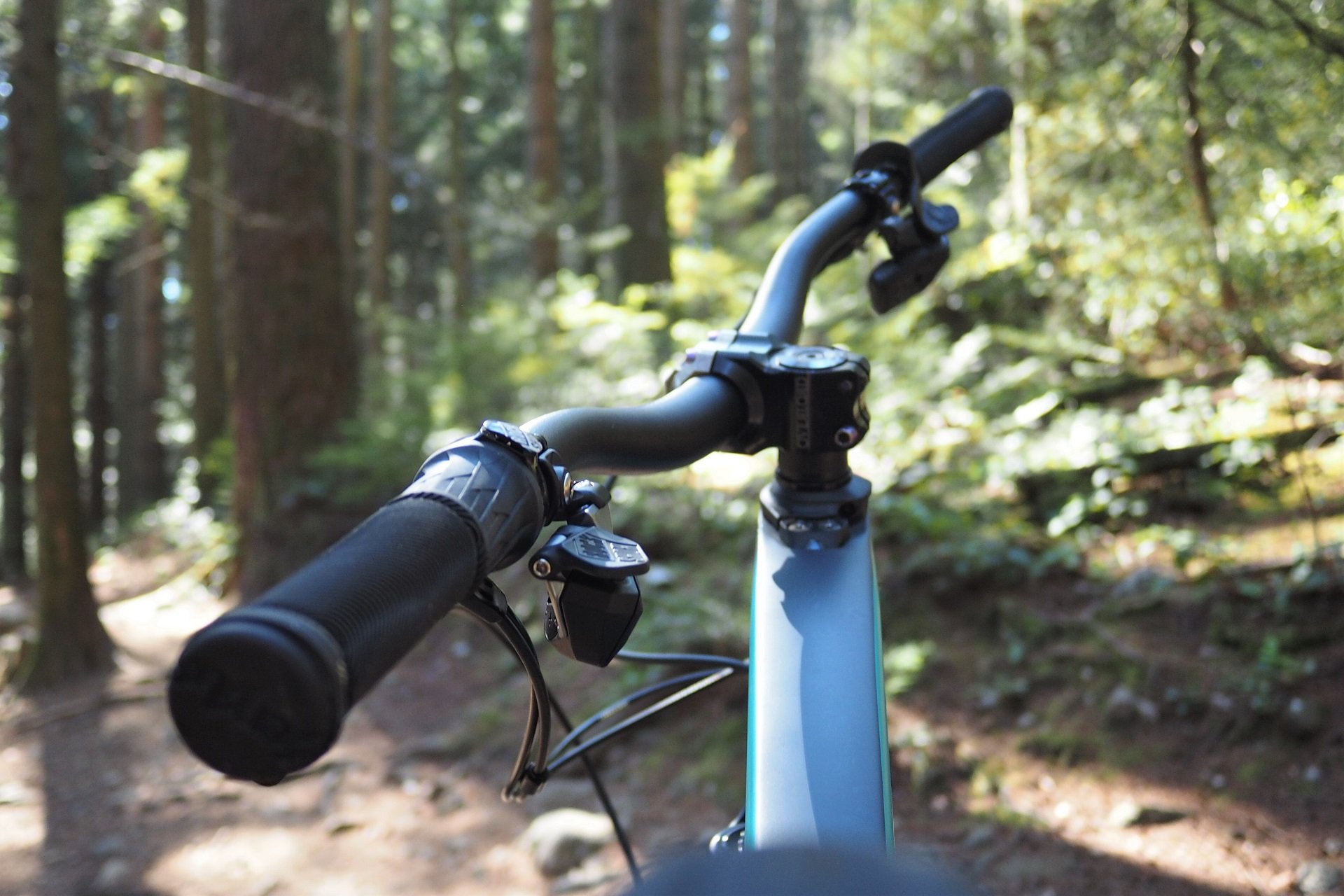
I haven't run a 60mm stem on a trail bike in years but would have needed on the medium frame. On the large, I ran my 40mm NSBillet and it was perfect. (Photo: AM)
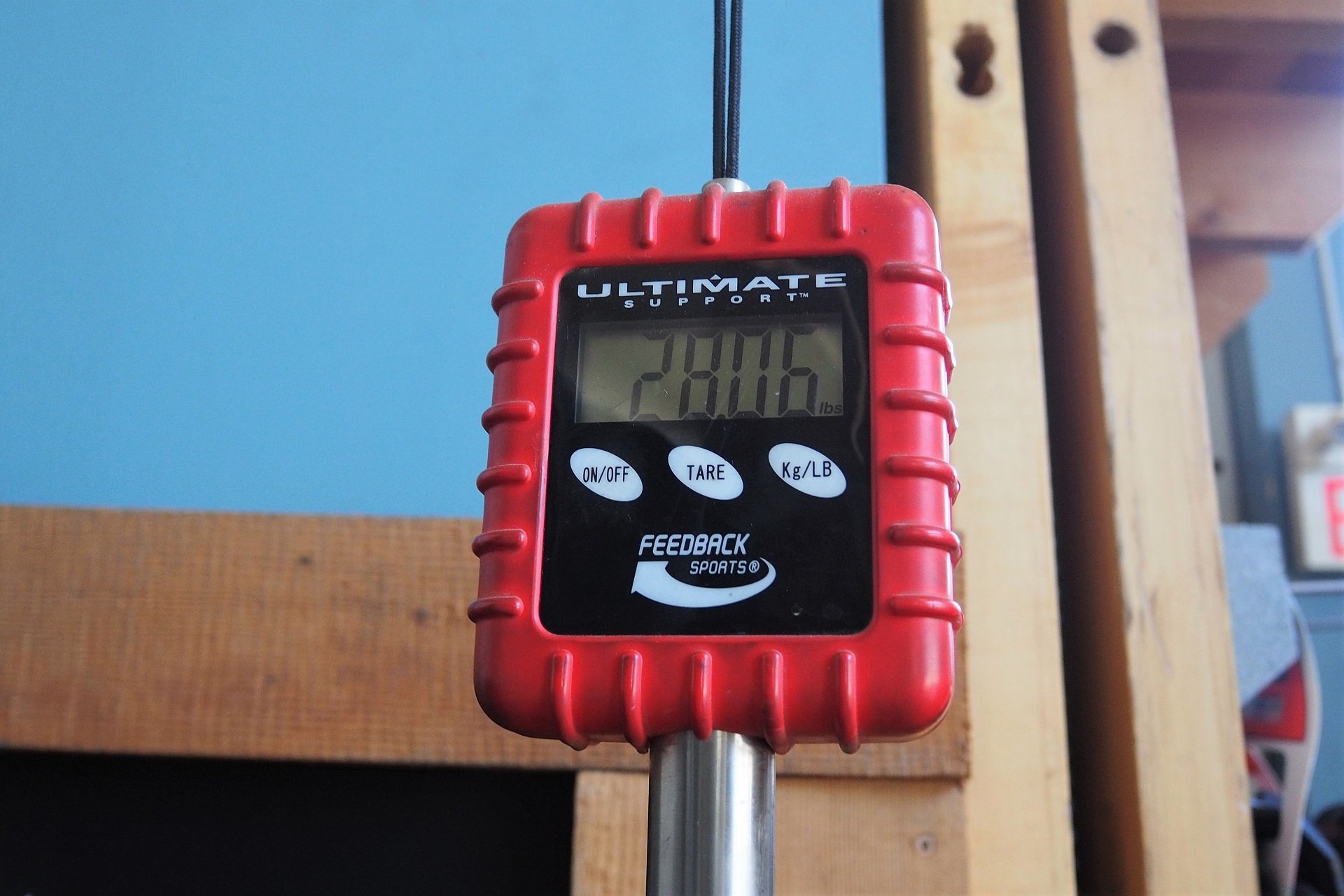
This weight is with composite flat pedals. I also installed EXO+ DHR2 up front and moved the Rekon to the rear and upgraded the front brake. (Photo: AM)
If this was my bike to keep, I'd be headed down to Roberts Composites to have the seat mast hacked off and a new seat formed for the collar down closer to the top tube. Cosmetics be damned, that 505mm seat tube length would be somewhere around 430mm. That's a full 35mm shorter than the medium Lux Trail and only 5mm longer than the small.
Since seat tube length is the number one reason the bike stopped being fun when the trails started being moist, dank, and glossy, wouldn't dropping down to a medium frame and adding a longer travel 150mm or maybe 170mm dropper post would have been a winning decision? With all the benefits of hindsight would I change size? I suppose it's impossible to say without actually riding a medium. But, the more I've rolled this around in my head, and the more I compare the fit of the LT to my own custom bike, the more I think Canyon screwed up in going with such a long seat mast rather than it being my screw up in riding too large a frame
AXS
The AXS drivetrain is both excellent and exactly not what I'm looking for when I'm in the forest. The chimera chirp of the little motor mated to the rear derailleur is a musical reminder of civilization that I don't get personally from the click of a shifter spooling and unspooling cable. That's me, and I still think that everyone who could and would choose to manage the economics of Eagle AXS should make time to give the drivetrain a try, even just in a parking lot.
I found it hard to go back and forth between AXS and a regular SRAM shifter. There's something ethereal about changing gears with AXS versus the more deliberate action of any cable system. I understand why so many folks are laying down cash or card to pick up an AXS upgrade or to purchase an AXS drivetrain-equipped bike. This is the only interesting thing happening in mountain bike drivetrains right now and this system works really well (I'm not saying cable-driven derailleurs aren't excellent).
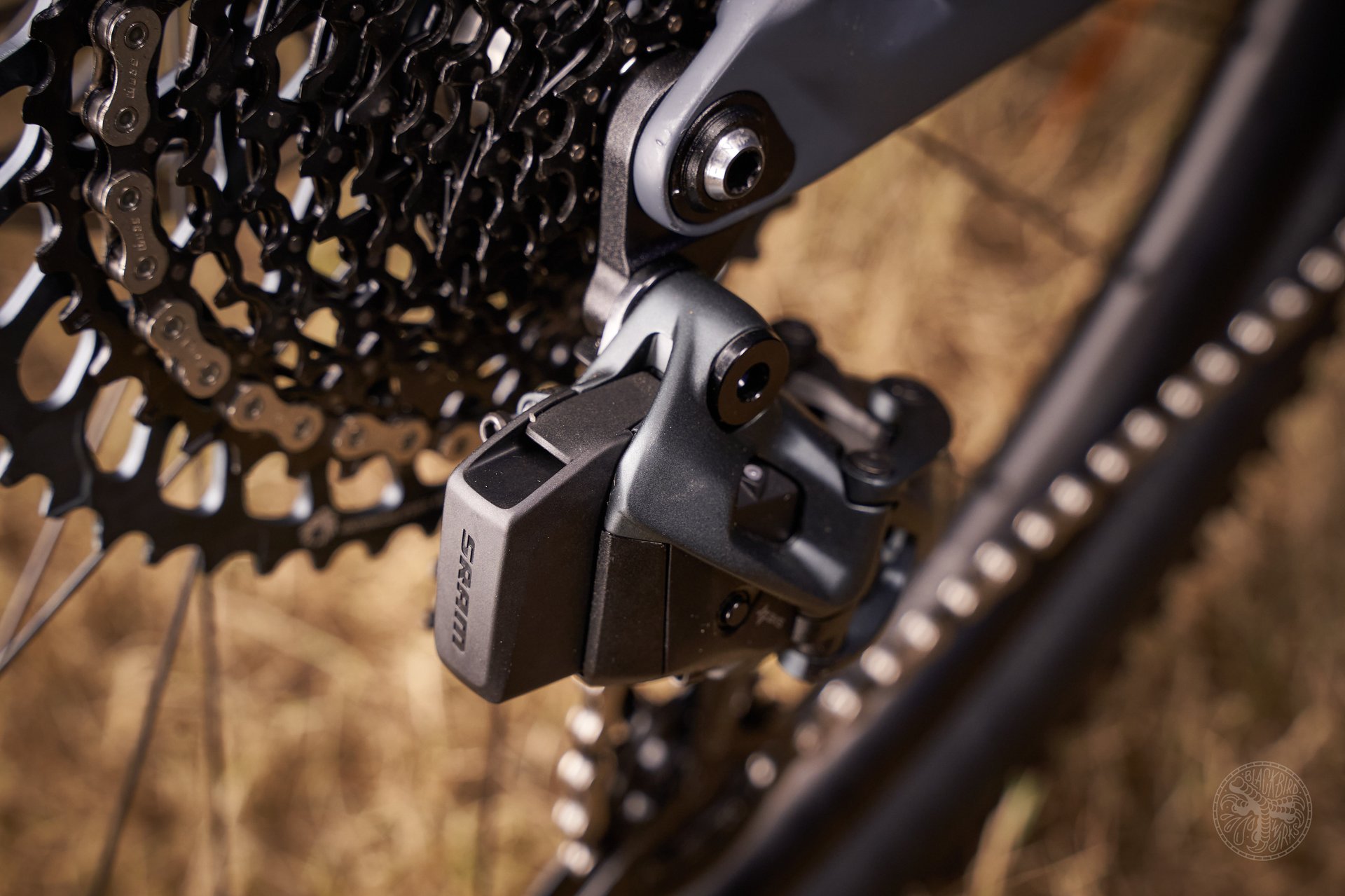
AXS GX shifts every bit as well as advertised. Some folks who've ridden both say higher end derailleurs are more precise but I can't tell the difference on the trail.
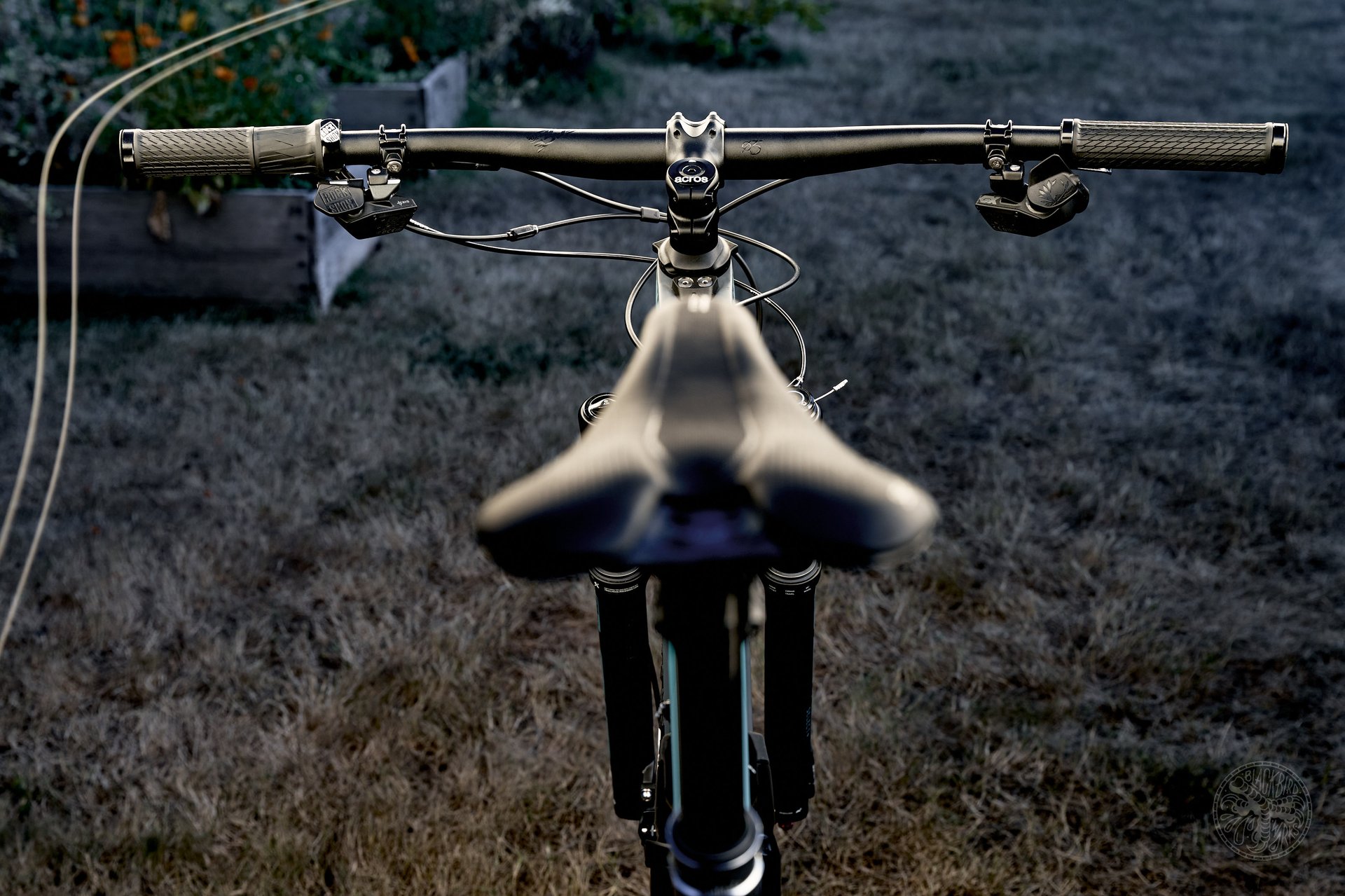
As much as I dislike taking batteries into the woods with me, I'm very sold on the AXS Reverb dropper post. I do think the Lux Trail should come stock with a 170mm unit in a size large.
The AXS Reverb dropper post is my jam. Despite the added management of two batteries and a wireless remote that could be removed in 3-seconds, I have to profess my love. The key feature for living in a rain forest is the easy removal of the post to let my bike breathe and drain. I wouldn't even store my post in my bike if I had one on my steel hardtail frame. I think it would be nifty if the Vent Valve was external like BikeYoke's Revive and could then be used, with a hex key, to lower the post in the event of a dead battery or motor issue, and yes it's out of my price range for what's justifiable to spend on a dropper post but that doesn't keep me from loving it in practice.
Highlights
It took me a while to get the suspension dialed in, mainly down the combination of the shock and suspension system wanting to sit close to a certain sag range through a decent range of air pressure. It's a much firmer riding example of a similar phenomenon to what I experienced with the ThunderVolt once we added the EVOL air can. It's easy enough to adjust into a sag range but within that range, it took a bit of playing around to find my happy place. The lower pressures required by the 2:1 leverage ratio also made it a unique setup experience compared to any bike I've ridden recently.
I ended up taking a shock pump to a section of a trail I ride very regularly. I found my optimum setup by incrementally adding air to the SID Select+ fork while incrementally removing it from the Deluxe Ultimate shock and then riding those settings right away. With my final setup, I was occasionally soft-bottoming the whole 110mm of rear-wheel travel and the last 15-20mm of fork travel was reserved for only the chunkiest "OH SH*T!" moments. I know that sounds like I'm leaving a lot of travel, out of 120mm total, on the table but with any less air the system felt unbalanced and that's with zero volume spacers installed in the SID.
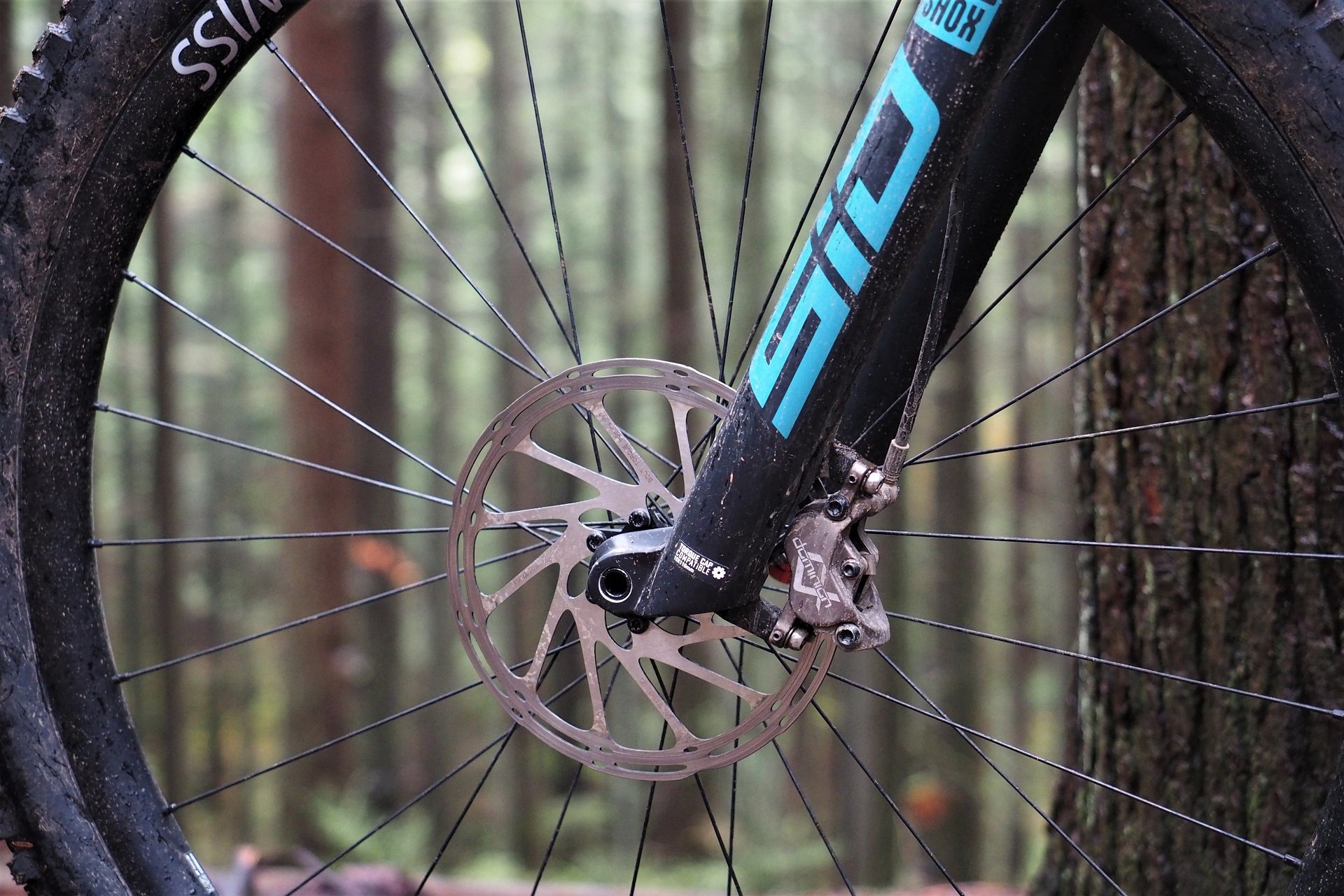
The SID+ fork could have been stiffer to play in the same system as the carbon frame & wheelset. It performed admirably for a lightweight XC option but I think a 120mm Pike Ultimate would be an improvement. (Photo: AM)
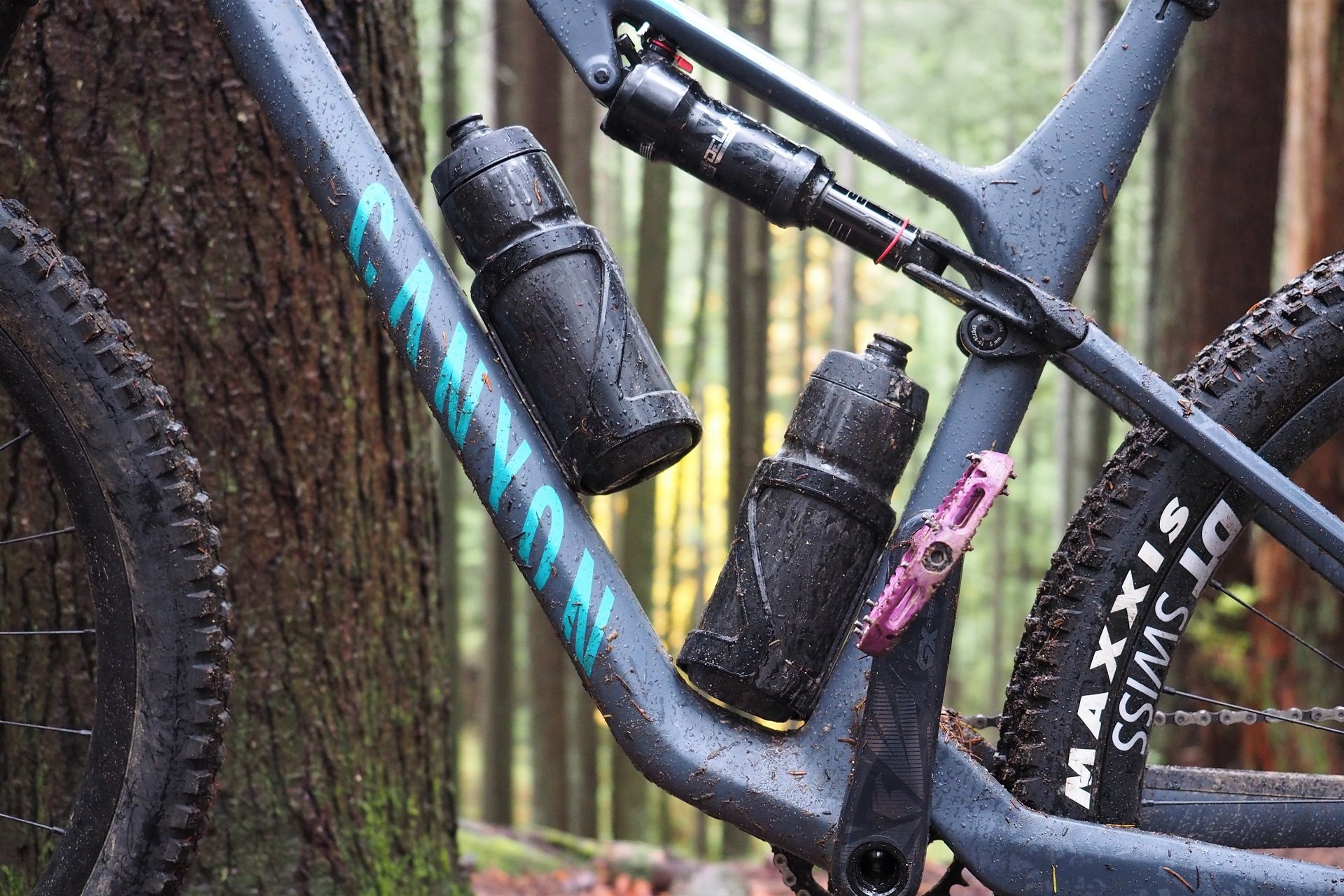
The frame, minus that Westendstraße-esque seat mast, is the highlight of this review. The 110mm suspension system is efficient and capable, the bottles are both usable, and I think it looks fantastic. (Photo: AM)
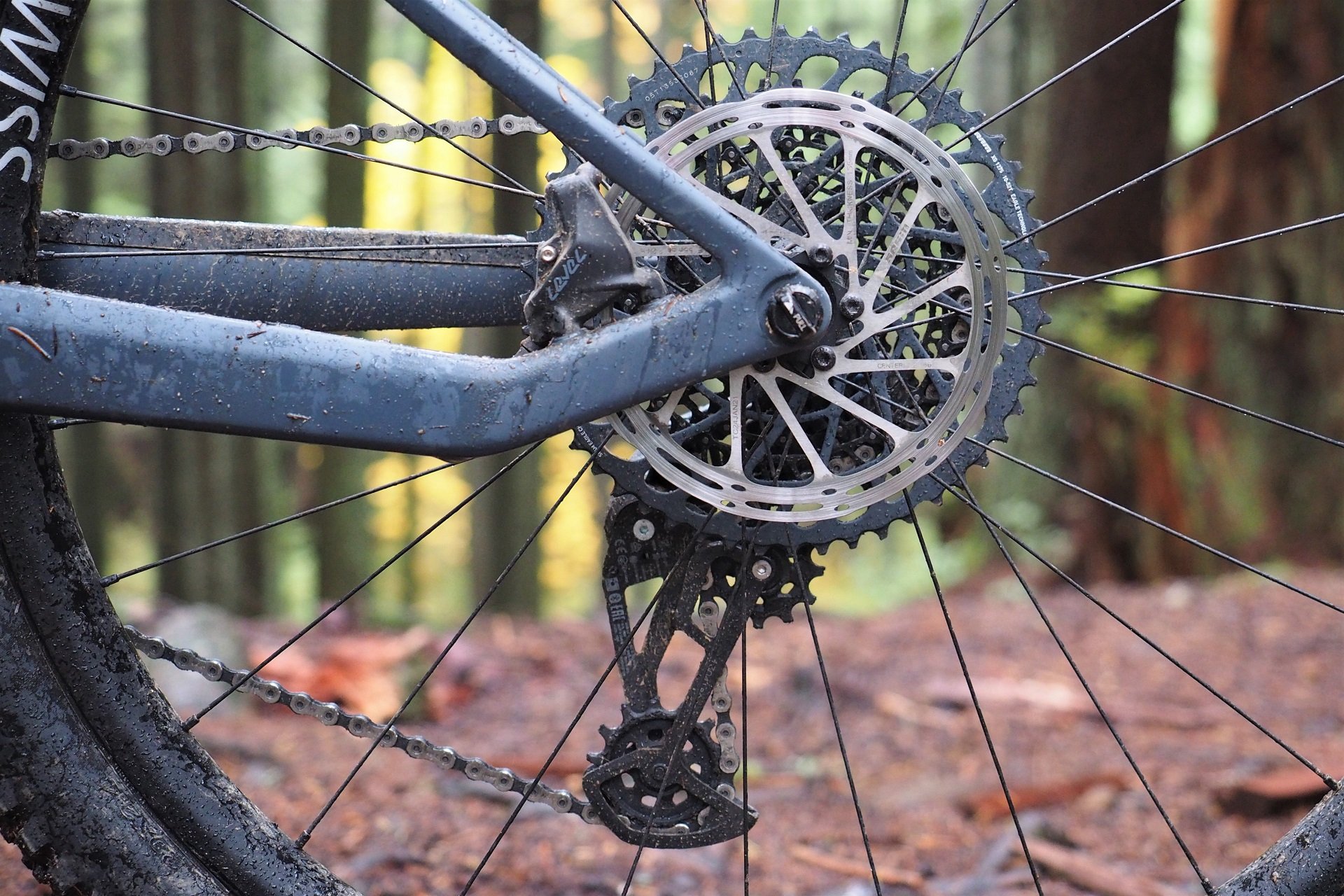
I'd prefer a standard 6mm hex key axle over the hidden tool-free option Canyon uses, but that's a very minor whinge. Flex stays are my jam for short travel rigs. (Photo: AM)
With the suspension dialed in, I never used the remote lockout. I would have removed the two superfluous cables if it was my bike if only because they murder the otherwise clean-looking cockpit. I didn't miss having additional adjustments on the fork or shock, which I find to often be the case with shorter travel v. longer travel bikes. The bike stood tall descending and was happy to be hammered out of the saddle, and it managed to be confidence-inspiring and capable in both situations. If I have the good fortune of testing other short travel platforms in the future this is absolutely the suspension standard I'll be measuring against.
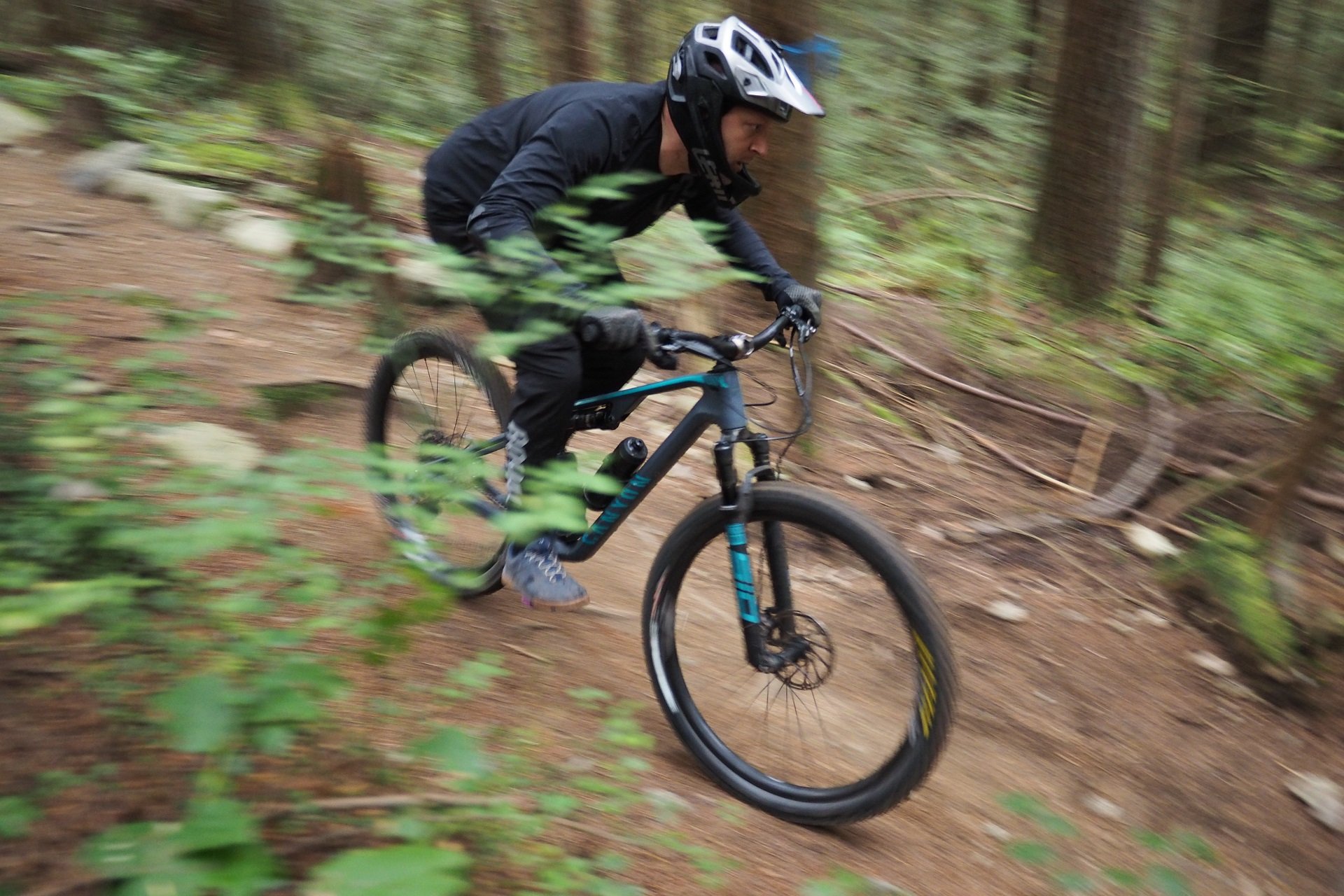
When traction is great and I'm attacking I can easily get away with the 120mm dropper post. Especially on the tamer, higher speed, trails. The Lux Trail really does rail when it's being pushed. (Photos: Mr. Lungtastic)
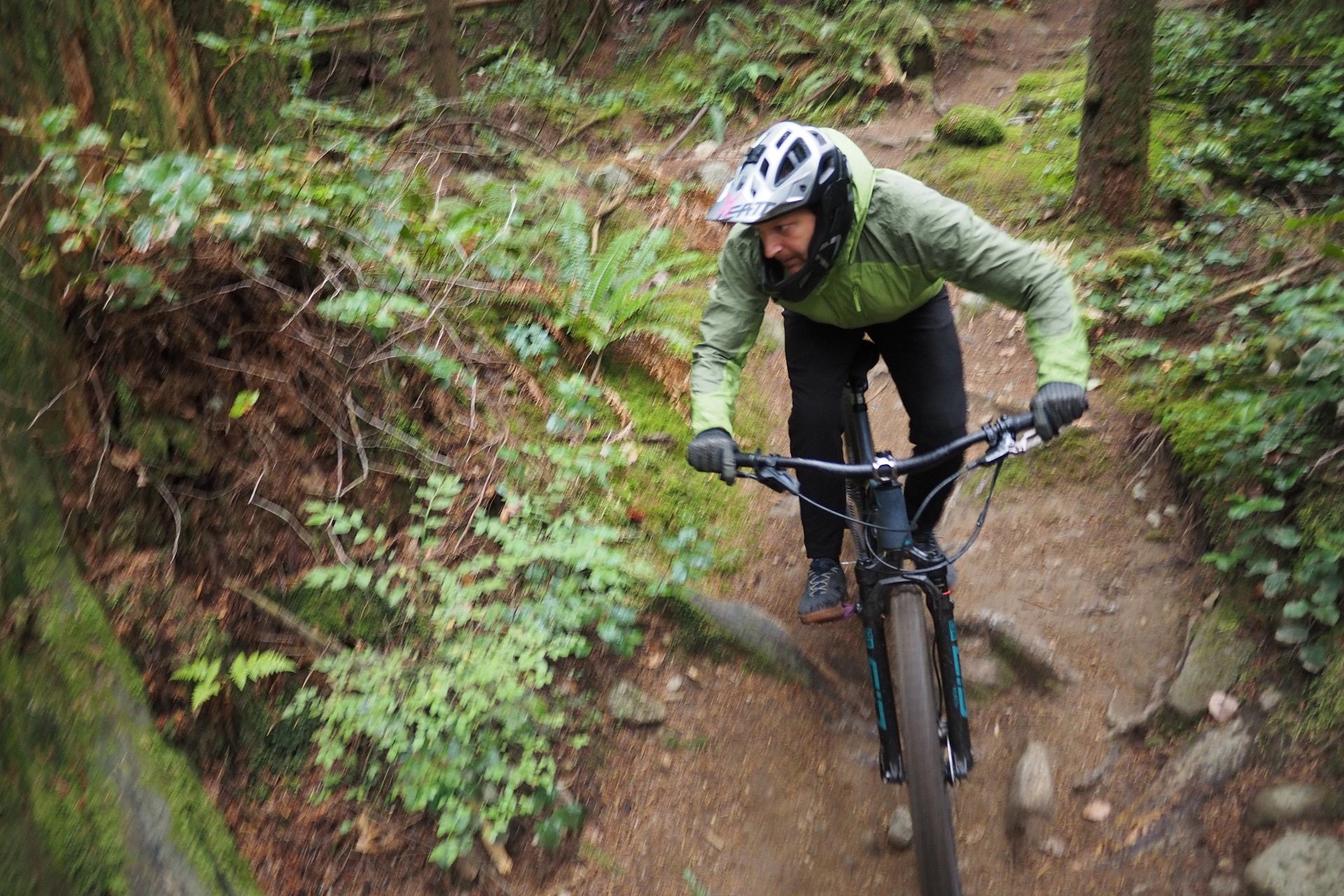
Even when trails were steeper as long as I was up and attacking everything worked well. Once the trails got greasy it was much less fun and sometimes a truly more terrifying proposition.
I'd change nothing about the climbing performance but I don't think it would have been negatively impacted by a slacker HTA. It responds to hard efforts, like a race bike, but many a time I also just socially pedaled up chatting with friends and the position and positive traction worked well in those cases too.
The long travel Banshee Titan is the most recent full-suspension bike that I rode down the trails within my Lux Trail envelope. The Titan is significantly longer, slacker, and plusher than the Canyon but I actually learned a lot about myself as a rider from the comparison. The Titan geometry worked better in the technical jank I like to find myself in; however, because I don't go big or particularly fast, the Canyon suspension platform was actually more fun in terms of pumping the bike and making momentum.
When I asked Canyon about a longer, slacker, and lower LT CF they pointed me straight towards the Neuron which is like serving someone a McDonald's Latte when they order a double espresso. Technically they're both coffee, but only one has the potential to be interesting.
Lowlights
I've mentioned the giant seat mast a few, dozen, times and I already covered the awful grips, bladed saddle, oversized chainring, and flat bar roadies brakes in my first look at the Lux Trail. The only thing I want to revisit from that list is the brakes because swapping out the front brakes, even while sticking with the stock 180mm rotor, made a massive difference to my LT experience. It frankly made having fun on the Canyon possible as anytime terrain turned steep the Level brake immediately made its lusterless presence known.
And look, every Transition Spur owner I know is either running Codes or whinging endlessly about upgrading their G2 brakes but I still think that a capable short-travel SRAM-equipped trail bike deserves at least a G2 brake system. Or go outside the groupset and spec Magura's awesome Trail Sport system. New rule: if it comes spec with Level brakes it's not a trail bike. If it's a trail bike it doesn't come with Level brakes. Simple.
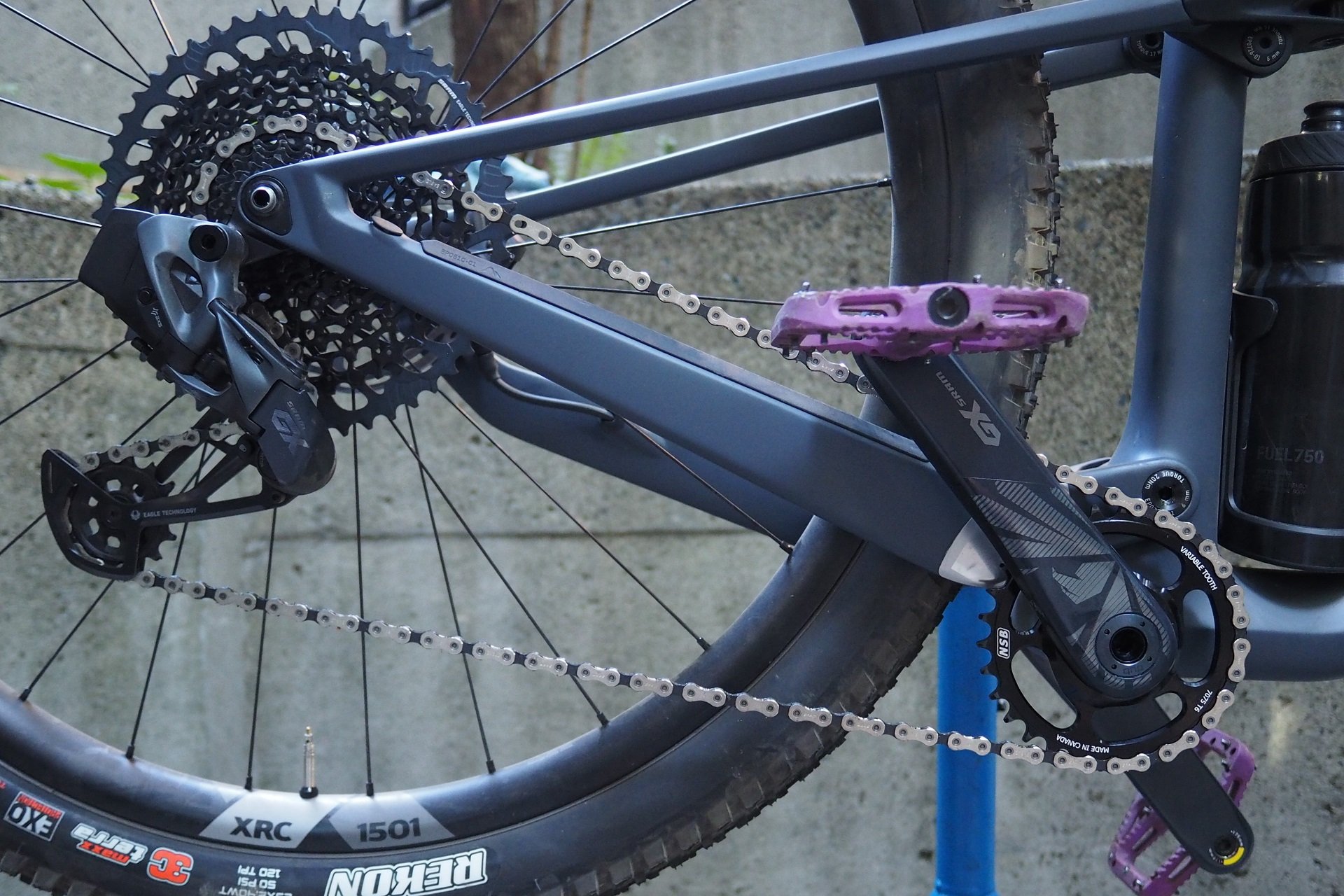
After my first ride, I swapped to a 30t NSBillet narrow-wide ring and ditched the chain guide. That's not in any way intended as slanderous towards SRAM's N/W ring profile, I just needed a smaller ring. (Photo: AM)
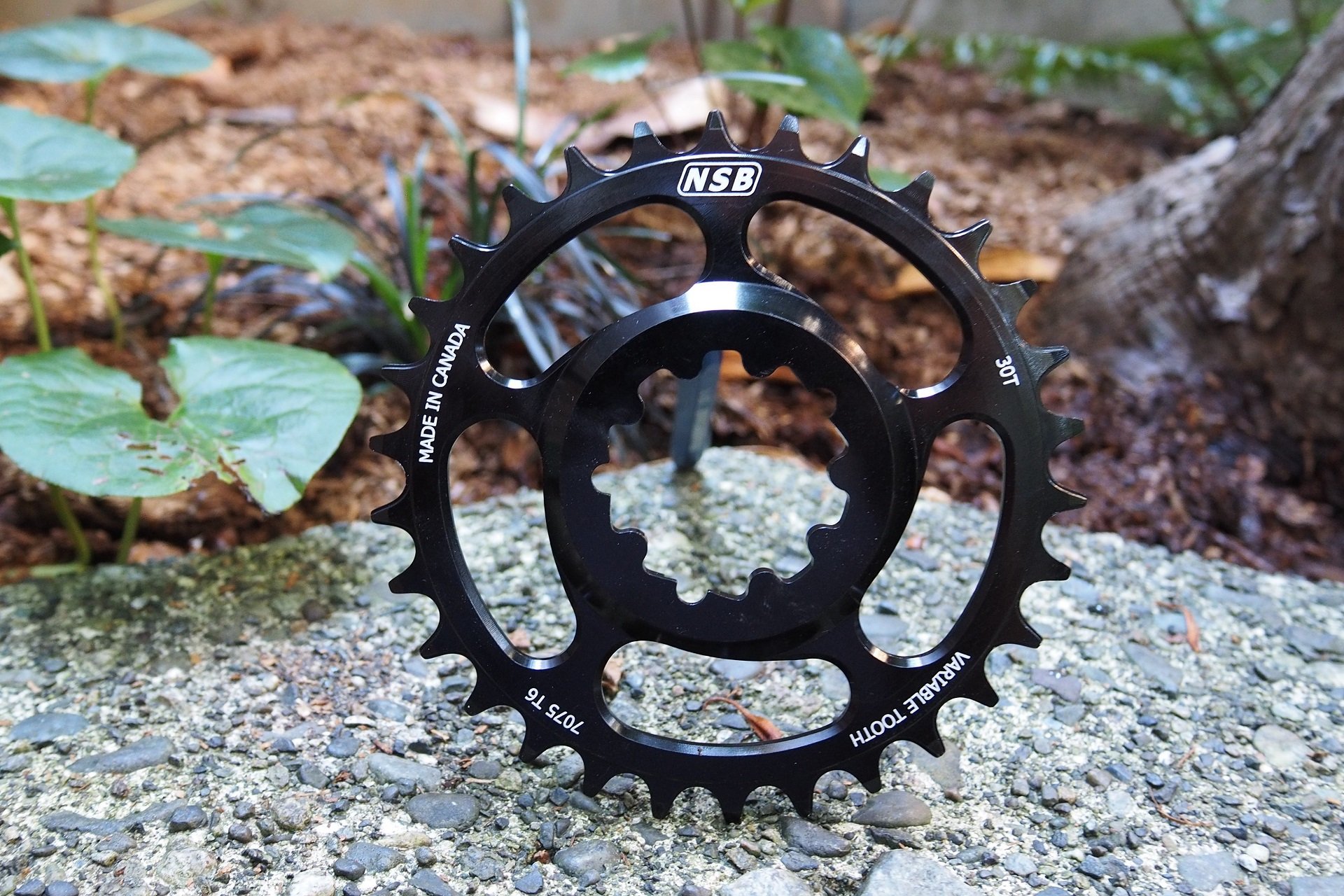
I chose a 30t because it was small enough that the 52t, aluminum, cog on the cassette could be a true almost-never bailout option and also because it would clear the chainstay. (Photo: AM)
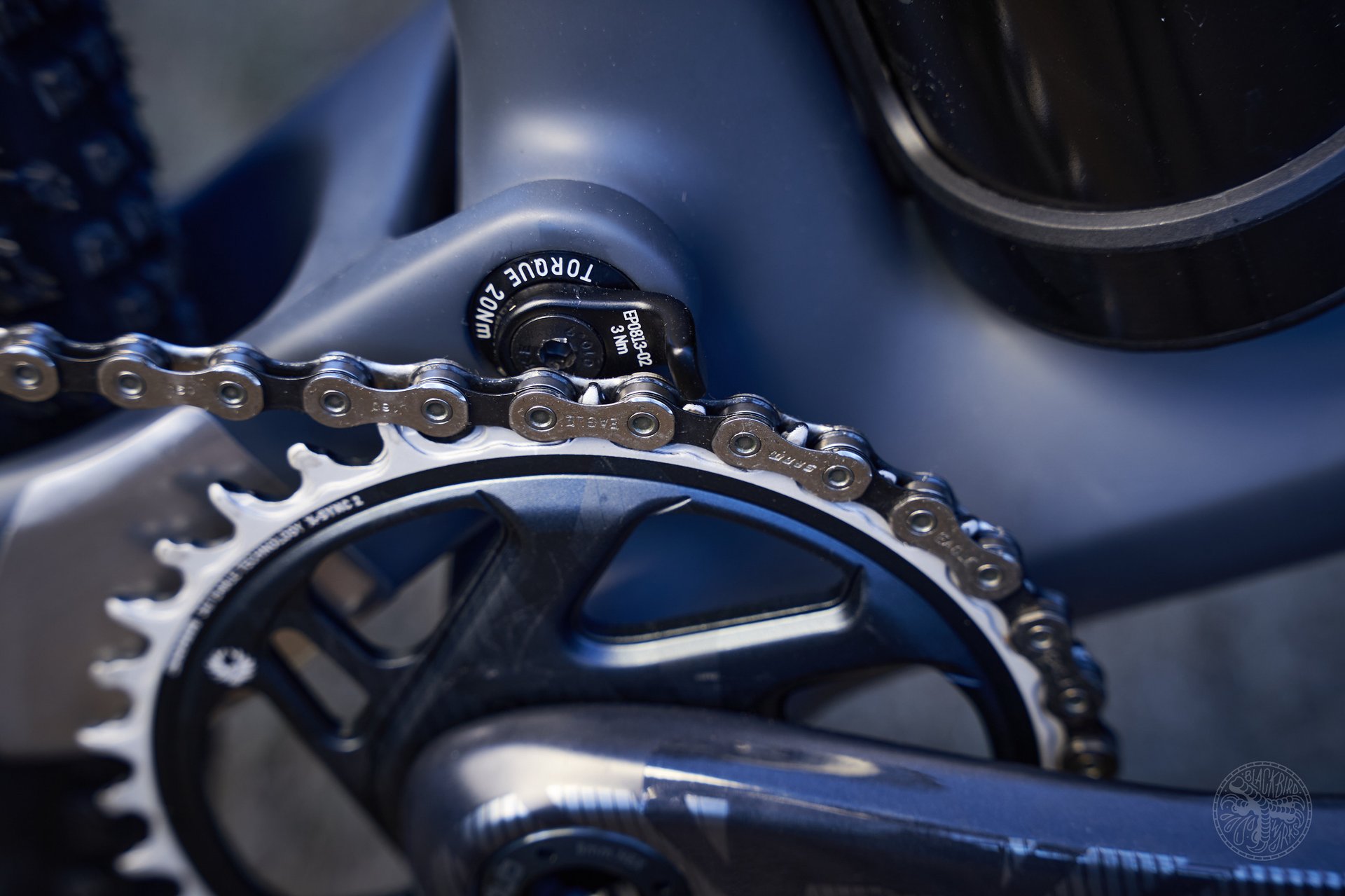
On a related note, I don't get why folks think the excellent SRAM narrow-wide ring profile needs a guide to help with chain retention. Or actually, any other narrow-wide ring I've used. Especially for a trail bike.
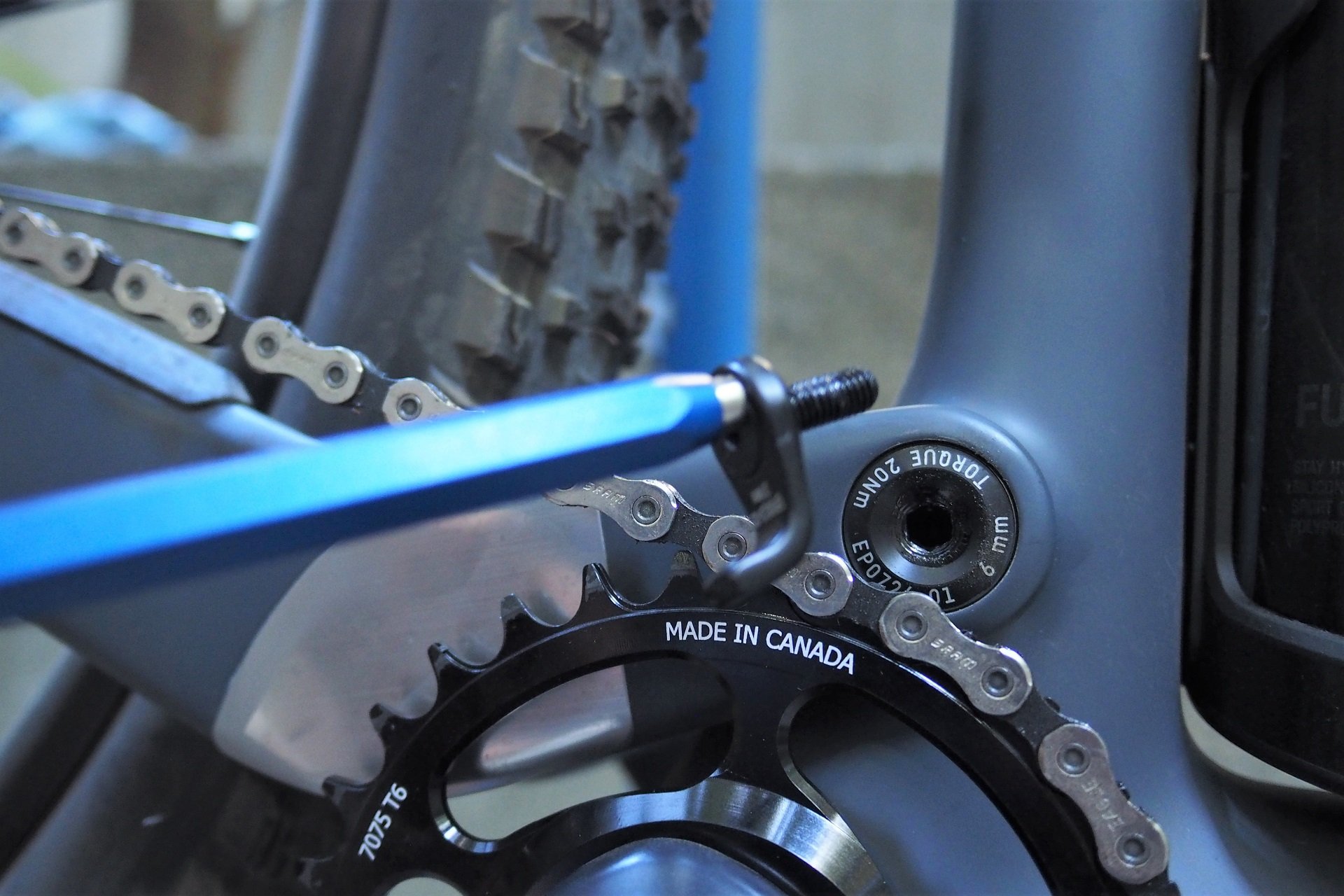
But let's say there's a good reason for the chain guide to be there. For example, the majority of riders want one. Why would it need the beefiest steel bolt on the entire Lux Trail bicycle?! (Photo: AM)
What Lux Could Be
So what is the Canyon Lux Trail? A prime example of the worst crime in mountain bike marketing and product management today. That is, of course, the unironic use of the term 'Down Country' to justify any components spec or frame design choice no matter how silly buggers it may be. Does your trail bike have light tires with the sidewall durability of a soggy biscuit and all the friction of a well-lubed rubber insert? Does it come stock with what amount to flat-bar road brakes? That's 'Down Country' baby. Does your XC-race bike come stock with a portly bar-stem combo, non-race-worthy rubber, and a marketing package that's anything but XC-racing? You guessed it, 'Down Country.'
I'm not throwing stones at other publications here because clearly, we're not immune to over-categorizing bicycles at NSMB either. Our own Cooper Quinn should be coated in TriFlow & Feathers for even suggesting the term 'Shore Country' and I swear if I ever see a brand with 'SHR CNTRY' emblazoned on the side of a mountain bike tire I'll make sure his family knows of their unending shame for the next five generations.
No, the Lux Trail is undoubtedly an XC-Race bike for the next generation of technical, but manicured courses. It can, of course, be ridden on any trail by a rider with the technical chops to make it happen, especially in the right conditions. But no amount of aggressive upgrading is going to take away from the relatively short wheelbase, relatively steep HTA, and towering seat mast when the average rider hops onto one in aggressive terrain.
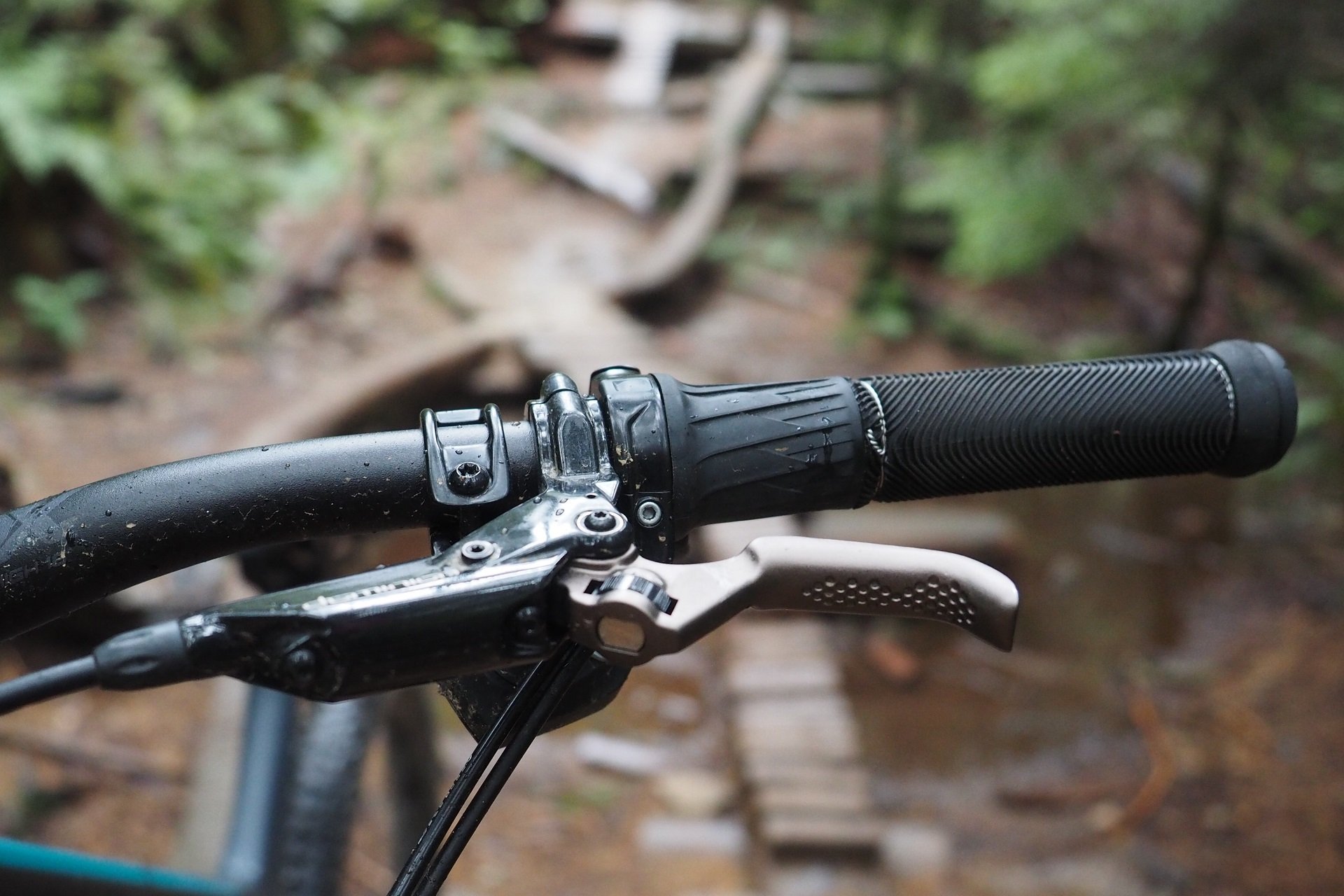
The Hayes Dominion A4 front brake upgrade saved the day. I also sacrificed a pair of Sensus Swayze push-on grips, shortened to work with the twist remote, which really improved my experience riding techy trails on the North Shore.
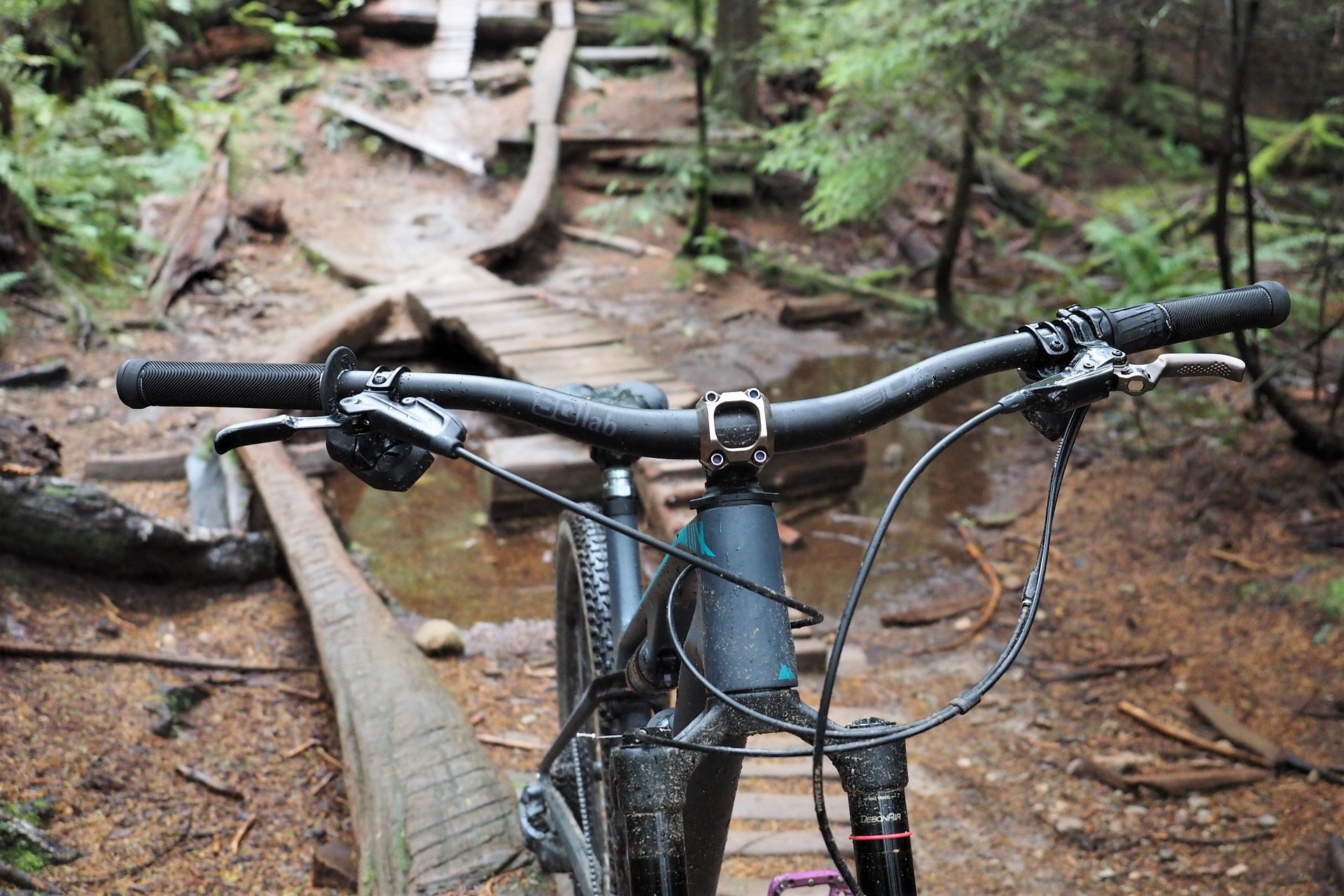
I've had some interesting Lux-related debates about what to expect from a mountain bike, or trail bike. The broad category of rigs that aren't dedicated to XC-Racing and clearly also aren't All-Mountain rigs that would be raced in the EWS.
What's killing me is that the Lux Trail could be so much more. The potential for pure joy when I ride this bike is always present. A next-generation Process 111 that cuts all the fat thanks to Canyon's sub-2000 gram frameset and updates a wonderful concept with a modern fit. Slacken that HTA by 2°. Cut the seat mast. Spec bigger brakes, a smaller chainring, a longer dropper post, and a DHF front tire with a Maxxis Rekon in the rear. BOOM. With every other part staying the same, for the same very fair price, the Lux Trail becomes the trail bike I really want to own with a firmer-is-faster suspension setup that isn't really comfortable but is remarkably capable.
I will be blindsided if the 2023 Canyon Lux Trail CF 8 doesn't erase the more traditional XC geometry Lux CF from their lineup next year. Or, maybe the year after. Or more likely, this geometry chart blended with a lighter layup will replace the Lux CF, and a meaner, more aggressive, Lux Trail will emerge. I'm going to say right now that when that slightly meaner, but hopefully similarly efficient, LT hits the market I'll have both hands in the air to test it.
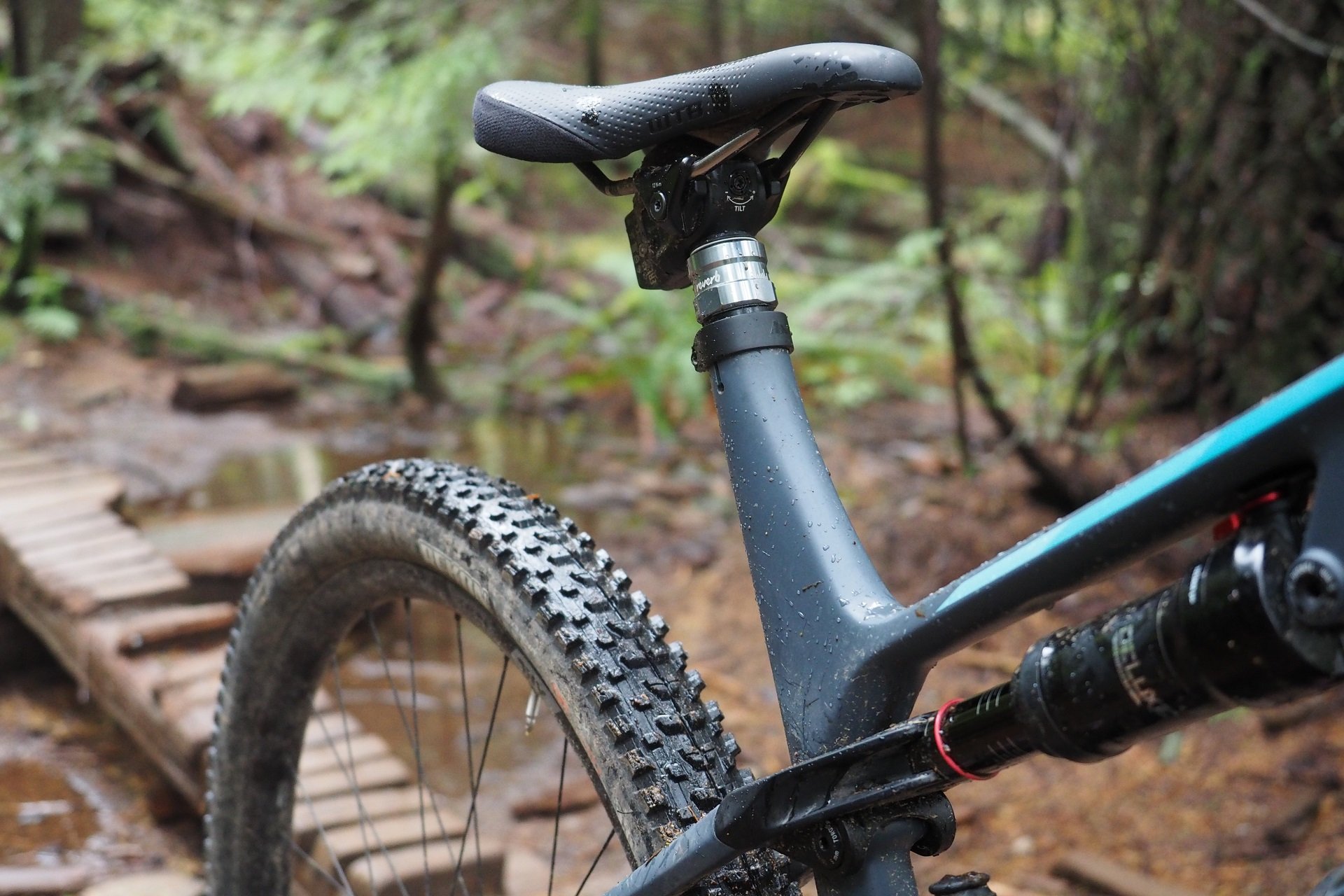
F***ing seat mast. Even without a slacker HTA the Lux Trail would be a significantly more fun mountain bicycle with a longer dropper post.
Refracting
Ignoring what I want the Lux Trail CF 8 to be and completely ignoring what Canyon is marketing it to be, it's obvious that this would be a brilliant race bike for the more technical XC courses of the future. It's efficient and ultra-capable. Just mount some 2.4" Aspen tires on the i30 rims, ditch hundreds of grams with a lighter bar and stem combo, pick a saddle that's not also a home vasectomy kit, and hammer. At 5500 USD | 7000 CAD for this build, with these wheels, and room to save weight yet, there's plenty of value in the build.
And, if you're riding the kind of terrain, or have the level of small-bike-skills where an XC-race bike makes perfect sense as a daily driver, and you have long legs or are perfectly happy with a 100mm or 120mm dropper, then have at it. The Lux Trail is going to be an excellent option for you. But please don't convince yourself that you're getting a Transition Spur or the like. Though, I do suspect that the next generation of Lux Trail will be just that.
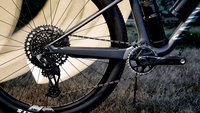
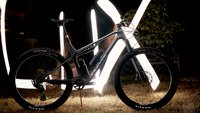

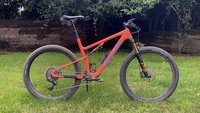
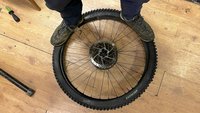

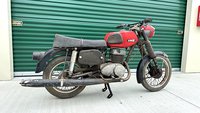

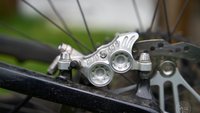


Comments
OldManBike
2 years, 5 months ago
It's fun to see a writer really hitting his stride like this. What a powerhouse review. Real mountain-bike journalism, stubbornly reader- and rider-oriented, is receding into history. It's a privilege getting to read quality work like this, don't let the Golden Age of Andrew Major pass you by unnoticed, people.
Reply
Moritz Haager
2 years, 5 months ago
Could not agree more.
Reply
Andrew Major
2 years, 5 months ago
Thank you,
Reply
Andrew Major
2 years, 5 months ago
What’s really fun is the messages I’ve gotten about when my “Age Of Andrew” and “Golden Age Of Andrew” stickers will be available.
My friends who read my work (and the comments apparently) would like to thank you for future hours of good-spirited piss-taking.
Reply
OldManBike
2 years, 5 months ago
Mission accomplished!
Reply
Andrew Major
2 years, 5 months ago
Hahahaha
Reply
Moritz Haager
2 years, 5 months ago
Great review. Really, really fair evaluation of the high and lowlights of this bike. Best line of the review: "Our own Cooper Quinn should be coated in TriFlow & Feathers for even suggesting the term 'Shore Country'". I actually laughed out loud at that, especially knowing how you feel about TriFlow. Interesting how conditions really exposed weaknesses of this bike. The shore is so interesting in that you can ride there in the wet. When it rains here in Edmonton the trails are essentially unrideable as it's all this clay based soil that triples the size of your tires in a nanosecond and is slicker than greased silicone. Sounds like this bike would absolutely scream on the trails here in Edmonton, but might not be enough to compensate for my lack of skills if I took it on a trip to BC.
Reply
Vik Banerjee
2 years, 5 months ago
I lived in AB for 17 years and my best mountain bike upgrade ever was moving to the BC Coast! ;-)
Reply
Moritz Haager
2 years, 5 months ago
Haha. No doubt. Love BC riding. Used to ride a lot more out there in the past when my buddy lived in Gold River and before kids. Geographically certainly would be my top choice as a place to live but so many other factors that go into that decision. That being said, Edmonton has a surprisingly good and extensive trail network that has really grown in the last decade or so. Singletrack starts 200m from my door and you can ride 100k in a day and not have hit every trail. For what it is, with the limited geography we have to work with, its not bad, but it's definitely not the shore.
Reply
Andrew Major
2 years, 5 months ago
Thanks Moritz!
I had a few texts this morning ~ suggesting this piece was a hit job on the bike and I really didn’t feel that was the case so I appreciate some confirmation. I tried to present a balanced look - if I was disappointed it’s only because of the potential.
I think this bike would be fantastic on flatter more manicured trails including technical ones.
I do think it would still be fun to rail around Edmonton with a -2* HTA and a longer dropper - while also them being more fun here - but I certainly agree you’d enjoy it on the trails there.
Reply
Kenny
2 years, 5 months ago
Suggesting a "trail bike" frame with a 505mm seat tube length in size L has some pretty inherent limitations for typical North shore use seems hardly like a hit job to me. I mean what are you supposed to say?
I also totally agree that the "downcountry" label can sometimes become almost a bit of an excuse for compromised component or geometry choices. In this case it's pretty obvious that it's not a purpose built "downcountry" bike like a spur or a banshee phantom, more a reheated xc bike. And hey, some people are looking for that, but youre just calling a spade a spade in this case, IMO.
Maybe it's a great bike but this site is NSmb, so I can't blame you for contextualizing the review to the typical North Shore use case.
Reply
Pete Roggeman
2 years, 5 months ago
Well said. If anyone can distinguish between DC and Trail as categories, I'm all ears. That's the fallacy of DC to me - it does nothing to help understand a bike, trail, or category that isn't already covered by either XC or Trail. Trail is broad and therefore perhaps a bit vague, but very few mountain bikers only want to ride on one kind of trail, so why would we need both categories? For that matter, as much as I also hated Enduro as a category (other than Enduro racing), Trail pretty much speaks to what mountain biking was from the very beginning.
I hate categorizations that don't help, but I know why we have them and even acknowledge that we need them. DC still sucks. Long live Shore Country.
Reply
Moritz Haager
2 years, 5 months ago
Honestly? That's ridiculous. I came away from this review with the impression that you think this is a great bike with really good suspension performance, but some geo and design choices that limit its use in more extreme terrain and conditions, which I think is pretty damn far from a hit job. I certainly did not come away from it thinking this is a bike I would never buy. If anything it increasd my interest in Canyon as a brand.
Reply
Andrew Major
2 years, 5 months ago
Yes, and cheers!
Reply
Pete Roggeman
2 years, 5 months ago
Well put. Reviews are nuanced, complex evaluations of a product. At least the good ones are. What most of us are subjected to on a daily basis is either people blowing smoke up the ass of something they got for free (aka the Youtuber/blogger/influencer 'review') or someone using their social bullhorn to bitch about their bad day (Yelp).
Reply
Cooper Quinn
2 years, 5 months ago
...don't hate the player...
Reply
Kenneth Perras
2 years, 5 months ago
To be fair to Canyon, North+West Vancouver's terrain and trails are incredibly unfriendly to DC bikes. This review might have been better served by testing in Squamish, but then it wouldn't reflect this publication's (niche) location embedded in it's name.
Even when developing RMB's new DC platform, our personal touches required for enjoyable riding here locally don't translate to the rest of the world where the trail networks are much better suited for these bikes.
Locally in NV, my Element has been immensely rewarding when hitting the climb trails on Fromme and Seymour, and tackling blue descents like Expresso and Forever After. Using the BCBR route of years past isn't exactly a fair spectrum of trails. This is a solo-ride bike, or with a group of friends who own similar platforms which, around here, is limited to just a handful of riders.
It is only after a few mods (tires, brakes, +10mm fork travel) that I am better equipped to ride more technical options like B-Brew, Lower Oilcan, C-Buster, and more. But then I've eclipsed the reasonable spec that serves this platform well in the ROW markets.
Some handy tips: 2.3 Minions (3CT of course) are in the same weight category as other DC appropriate tires, such as the 2.4 Rekon. You trade rolling resistance for winter traction and better mud clearing abilities. The OneUp 180mm dropper is the lightest reasonably priced dropper out there and has a low stack height for the vertically challenged.
Reply
Andrew Major
2 years, 5 months ago
From a suspension travel / performance perspective the Lux Trail is exactly what I'm for in a personal bike, and local trails are where I'd be riding it, so I think that's a fair set of circumstances to test the bike under?
I'd love to try the same bike with a shorter seat mast, slacker HTA, and some different spec options - which I was obviously prepared to make as part of adapting a bike to local conditions - and my belief is that in that configuration it should be at least as enjoyable on the trails where my rigid bike is fun (to me).
No doubt the OneUp is currently winning the dropper post arms race, but there's not way to get around the 505mm seat tube length here.
Reply
Geof Harries
2 years, 5 months ago
To each their own, as I believe a 500mm+ seat tube length is ideal on a Large bike but this also because I have very long legs.
I could push a 210mm+ dropper post into that Large frame you tested and still have room for more. 430mm like you mention is an instant showstopper for me. So tiny!
Of course, I'm finally on a proper big person trail bike - Trek Fuel EX in size XXL - with its glorious 540mm seat tube and a tall stack height to match. This, combined with a 170mm dropper post and I could easily still have room for something longer.
Agree on many of your other points, though. Also, as others have mentioned coming at the review from a north shore perspective is what's important and unique about this website, and the experience of and expectations for riding bikes there.
Reply
Andrew Major
2 years, 5 months ago
I'm missing something. This is a large bike, not an XXL. It has a 480mm Reach, which is the same as my custom hardtail, which I call a M/L.
I don't see an XXL Fuel EX on their 2022 geo-chart but the XL has a 500mm Reach, 500mm seat tube length, and a 662mm effective top tube length. That's a proper big bike and seeing all those numbers go up 20mm for an XXL would be normal. I'm not asking for a 430mm STL on a XXL. Although, I'd still maintain for the application most my friends tall enough to ride an XXL bike would like to run a 200mm+ post so whatever the STL is it would easily accommodate that.
Reply
Geof Harries
2 years, 5 months ago
Sorry for the confusion. What I meant is that for someone with really long legs but who would fit on a Large bike, a 430mm seat tube is too short.
Again, to each their own. I recognize that I am in the minority and more people are equally or reasonably proportionate.
Here's the link to the XXL Fuel EX. They only make the XXL in certain Fuel models.
Also, is this not the bike that Mathieu van der Poel races on? No wonder it was so fast, efficient and terrifying in and around Vancouver! I wouldn't want to ride it either.
Reply
taprider
2 years, 5 months ago
I'm in the minority too, as I would prefer a larger main triangle bag over a longer dropper.
Draw a straight line between the top of your rear tire at full shock compression and the highest point of your stem. I don't see any point in having your seat any lower than that line (or how low can you drop your saddle until the rear tire hits your battery). Based on your Lux photos, I don't see that cutting any more than 2 cm of seat mast would be possible, and would still enable the space in the main triangle to be larger (best of both worlds).
Andrew Major
2 years, 5 months ago
The space in the front triangle is huge and doesn’t have to get smaller to hack off the seat mast.
Apparently a fair few folks have lost their AXS batteries from contact with the rear tire, so that’s a valid thought. But then, the vast majority of Lux Trail bikes, never mind FS bikes in general, don’t have AXS posts.
Cooper Quinn
2 years, 5 months ago
I have to run the 100mm dropper post SLAMMED on this bike, and the rest of it is the 'right' size for me.
Sure I could gain a touch with a One Up post, but not enough to really matter.
Reply
Andrew Major
2 years, 5 months ago
It's a 120mm and yes. Your Spur is a large as well?
Reply
Cooper Quinn
2 years, 5 months ago
Sure, 120mm. Also a large.
That said, I haven't found the dropper to be much of an impediment to fun on the Lux - the other geo holds it back enough that its a non-issue for me. But I would absolutely much prefer to fit a longer dropper.
Andrew Major
2 years, 5 months ago
I did fine with the 120mm dropper and probably would have done better if I was clipped in instead of riding flats, until trails became steep. Then the conditions changed and the angle and aggressiveness of trails where the 120mm was okay became much flatter and tamer.
I run 4" and 5" dropper posts for years (though again, clipped in) so it's not like I don't know it can be done. But there were days on the Lux I would have given up brakes altogether* to get another 30-50mm of drop.
*clearly an exaggeration?
Kenneth Perras
2 years, 5 months ago
For sure. I'm not here to slam a competitor for their choices, but rather to highlight that the Shore is an incredibly unfriendly place for most bikes. Our needs are here are, uhm, "special".
Reply
Cr4w
2 years, 5 months ago
This bike would be great for a huge proportion of the riding public just about anywhere else.
Reply
Kenny
2 years, 5 months ago
Really?
Seriously a 505mm seat tube on a size large trail bike is not a positive feature for the majority of people.
It has a long seat tube because they repackaged an xc frame as a downcountry bike and as such it has limitations.
Reply
taprider
2 years, 5 months ago
"Special" as in "need"ing greater durability?
Both Rocky Mtn and Norco are known for relatively high weights for their XC FS race frames. But then they last more than one year too. So a big plus for local bike companies.
I like the look (and probably would like the geometry too) of the Lux, but am leery about flex stays. One less pivot, but thinner stays to allow flex, might mean less impact and abrasion resistance.
I am not one "need"ing a longer front centre (relative to rear centre, but a little longer overall wheelbase would be ok). To me, flat and uphill cornering ability is more important than anti-endo ability, so seeing that the new Element has a 71mm longer front centre and 2 mm shorter rear centre is not enticing.
I did experiment with a -1.5 degree headset for most of a year and the only thing that really changed for me was greater understeer (I did not get any braver down steep rock faces into rough run outs)
Reply
Cooper Quinn
2 years, 5 months ago
We're snowflakes, Ken.
Reply
AndrewR
2 years, 5 months ago
@AM Nice write up as always.
Ref your point about chain guides and NW chain rings for chain retention. They are not there for chain retention but rather reducing lateral play which reduces wear to the chain which reduces wear to the $250-700 cassette.
We (mountain bikers) also regularly back pedal (even if it is only 1/8-1/4 of the clock) an unloaded chain that is being trashed about by the trail impacts and suspension movement so a chain guide helps keep that little chain of links where it ought to be rather than off either side of the chain ring when we are getting tech and or rowdy.
OneUp (obviously they sell them so they have a vested interest) wrote a piece about it a while back.
Kudos for mentioning the well known (in the S2S) tip of running the size of chain ring that allows one to avoid the 50-51-52T alloy cog other than when totally gassed and competing with a mountain goat. Obviously there is no issue pedalling 34T in Chicago (XX1 standard chain ring size).
The other 'tip' is to run a non boost chain ring on a 'boost' system to optimise the chain line for the lower/ bigger gears that one spends hours pedalling and grunting in versus optimised for the higher/ smaller gears that one might spend 10 minutes per ride pedalling in to maintain momentum when already going quite fast.
I would really like NS Billet to start making steel NW chain rings so I can buy more local than Minnesota!!
Reply
Andrew Major
2 years, 5 months ago
NSB needs to make Oval rings too! On my Singlespeed, with flat pedals, I have to have my oval!
Interesting about the chain guide. I’m having a hard time visualizing since through the range of a cassette the chain approaches from different heights and angles (so the guide doesn’t exactly hug the chain/ring such that it wouldn’t still bounce up/down side/side. Food for thought though.
Reply
Vik Banerjee
2 years, 5 months ago
Thanks for the review. Having ridden aggressive hardtails almost exclusively for well over a year now and being impressed by how capable they are I occasionally wonder about an aggressive short-travel FS bike to get a sweet mash-up of the HT feel with a bit of FS compliance. I can't decide if that will be the best or worst of both worlds!
Reply
Cr4w
2 years, 5 months ago
I've thought about this a few times but couldn't do it. These light FS bikes are light, generally have conservative geometry and short chainstays but most importantly of all, pinner air shocks. By the time I get a bike like to a minimally survivable state it weighs within a few pounds of a more suitable bike so why bother with all the compromise. Hardtail for pep. Proper FS bike for smash.
Reply
Andrew Major
2 years, 5 months ago
My SB104 wasn’t lightweight. It had CushCore, real tires, a lowered Durolux (120mm), a full length dropper and the only carbon was the frame which is quite a bit heavier than the Lux and it could be incredibly fun (and would have been brilliant with a higher BB).
I think a bike that’s capable not comfortable is brilliant fun. It lets a more average rider, like myself, push a bike in a way they just can’t/don’t/won’t with a longer travel bike.
It’s poppier and more playful but the geo and big brakes keep it stable an controlled.
It’s not a new idea, and I think we’ll see a lot of fun bikes in the category in the next wave of bike design - just as HP+I bikes wane in popularity in favour of bikes that are many pounds lighter and much simpler.
Do hope Canyon is one of them. Wouldn’t take that much work to make the Lux Trail ridiculously fun for the next gen product.
Reply
Timer
2 years, 5 months ago
Isn’t that kind of bike already very common? Tallboy, Optic, Phantom, SB115, Spur are just the ones that immediately come to mind.
Reply
Andrew Major
2 years, 5 months ago
Not really, no. At least not in my mind. I'm still working on my SB104 piece so I don't have my explanation totally dialed yet.
I think Cpr Qnn did a good job comparing the Spur to the Tallboy in terms of how different they are on the trail. I'd like to try a Spur built with aggressive tires and a -2° angleset to see if I'm out to lunch but when I ride the Lux Trail the suspension is exactly what I'm looking for, and that's not the case with 130/120mm bikes which often just feel like their longer travel compatriots only they bottom out sooner.
Reply
Timer
2 years, 5 months ago
Looking forward to that piece. I think I might have some idea what you mean. Both Tallboy and Spur aren't XC bikes and their suspension doesn't have that racebike feel. What are your thoughts about the Epic Evo or new Spark?
Andrew Major
2 years, 5 months ago
I would love to review the Epic Evo, especially now that 9Point8 makes an Angleset for it. I think so many of these bikes error on the side of caution with geometry where too steep is much easier to define on the trail than too slack.
The Kona Hei Hei is also potentially interesting, again with a -2* Angleset. Again with carbon flex stays.
Another bike that I would love to try is the new Trek Top Fuel.
Cooper Quinn
2 years, 5 months ago
I've borrowed the Lux for one ride so far. The Spur and Tallboy are much closer than the Spur and the Lux.
There's a lot of potential in the Lux, but at this point, its baaaasically just an XC bike. A good one! But an XC bike. Which means its pretty scary around here.
fartymarty
2 years, 5 months ago
In my mind it's Walt V2 with 100mm of rear travel and 120mm up front.
I get it and am curious. While a Spur looks like a blast it's geo probably isn't progressive enough.
Reply
Andrew Major
2 years, 5 months ago
I think where the Banshee Phantom becomes the most intriguing bike to me in this category - weight and all - is that longer (and adjustable) rear center. It's easy enough to angleset most bikes (including the Spur / other than the Canyon Lux with its Turducken headset). Certainly, a Spur would be on my shortlist if I was buying an off-the-shelf trail rig. No Trunnion mount and a flexstay pivot!
Cooper Quinn
2 years, 5 months ago
Horses for courses. IMO the Spur doesn't need to be more "aggressive" you can already get yourself into plenty of trouble on it!
Andrew Major
2 years, 5 months ago
I'm no Cooper "Shore Country" Quinn, I'm thinking that, like my rigid bike, more aggressive geometry will keep me out of trouble where it might get a faster rider into it.
I also always think of bikes from the perspective of only owning one. My Spur would have a more aggressive build than yours if only to increase the terrain that I'd be comfortable riding it on.
Vik Banerjee
2 years, 5 months ago
One option I've thought about is custom steel FS bike. 4-bar without the CS pivots for a lighter flex-stay setup. Peter at Daambuilt made himself a FS bike that built up ~30lbs without a crazy light build...so you could get it to the same weight ballpark as the carbon one reviewed here. Although I am not overly worried about weight.
This would allow custom geo and custom suspension tune as I'd want a very progressive rear end.
In terms of the why? Same why for any sub-optimal setup/bike choice...it's fun/interesting to go into a gunfight with a butter knife and win. I could build a FS bike that would out perform or match a HT in every performance category for Coastal BC trails. So if my only consideration was performance I'd never bother with a HT at all.
Reply
Andrew Major
2 years, 5 months ago
I can’t bring myself to do the custom FS thing. I just get too attached to bikes with that level of personality so even if it wasn’t what I thought it was going to be I’d have to keep it and either have it staring me all the time ready to ride or hanging on a wall reminding me of the bad investment.
I feel like there are a few off the shelf frames I could get there with Anglesets, or varying shock stroke, or mulleting, etc.
Reply
Vik Banerjee
2 years, 5 months ago
Nothing wrong with some wall art if it came to that. The nice thing with a steel frame is it can be re-made/adjusted if needed without getting scrapped assuming you got things into the ballpark of where you wanted them initially.
The cost of a modern carbon FS frame is so high and medium term re-sale price so low it's not like you are taking a huge financial risk going steel/custom from a non-BLING$$$ builder.
Reply
Andrew Major
2 years, 5 months ago
That’s where I keep coming back to the idea of a crate rear end. Then I can test a suspension and make certain it’s what I want, just attach it to the geo I’d like up front.
I’d love to try the Lux Trail blended with my Waltworks.
tashi
2 years, 5 months ago
I’ve considered a custom FS from Marino as the lower cost reduces the risk ( does someone making fully custom frames ALSO know how suspension should work?) while getting the custom geo and repairability of steel.
Reply
Andrew Major
2 years, 5 months ago
My understanding is the software available for modeling suspension geometry - especially now that everything is 1x - is actually very capable? Certainly, if I was going to spend the money on a custom it would be a multi-pivot bike. I won't be falling for the Starling Fallacy myself - with Marino or otherwise.
Perry Schebel
2 years, 5 months ago
given marinos are so silly cheap, perhaps one shouldn't really expect sophisticated kinematic analysis, but i've seen some pretty terrible (eyeballed) leverage rates on some of those frames. looks like the swingarm shock position is fixed, and you get to choose a shock stroke, and the downtube shock mount just ends up where it ends up, given those & the geometry parameters - often in territory that no amount of volume spacers can fix. that said, if one spent a bit of time messing about in linkage to confirm some numbers that don't suck (assuming you can get enough hard data from marino), it's a damn cheap option to play with some interesting numbers.
HOWEVER, having spent time on an optimized simple single pivot, if it were my $$, i'm in andrew's camp - it'd be a linkage actuated bike.
Perry Schebel
2 years, 5 months ago
daam, that's sweet.
Reply
Andrew Major
2 years, 5 months ago
It's so clean... from another daamension!
Reply
Vik Banerjee
2 years, 5 months ago
He builds Daam fine bikes. ;-)
Andrew Major
2 years, 5 months ago
At the same time I was finishing this piece I was starting my write up on my SB104BBR project. On the one hand, it was a brilliant failure. But on the other hand the potential for long, slack, and (not too) low short travel full suspension bikes is brilliant.
I enjoy the efficiency, the traction, and the pop immensely and feel I can push a bike like that whereas with my guts and abilities on a bike like the Titan I’m more along for the ride.
Reply
mikeynets
2 years, 5 months ago
Not to hijack the comment section on the Lux review, but you got me thinking about a couple of things: any more articles coming soon about the Titan? and would you consider the Phantom for your hypothetical crate suspension-custom front triangle build?
Reply
Andrew Major
2 years, 5 months ago
No, I’ve returned the Titan. It received a lot more attention than most review bikes. Partly because it was a frame-up build and partly because it was interesting. My “2nd” review has a bunch of links to stuff it featured in.
I really like Banshee’s suspension design. I think one of the advantages is how the bikes are built from a front and rear forging, joined by two links, and then everything else is welded on, so I would consider an Angleset equipped Phantom whole heartedly but wouldn’t use the back end for a crate project.
I’d sign up to test a Phantom frame in a heartbeat. The one thing that would arrest me from buying one is my utter dislike of Trunnion mount.
———
Hope that’s interesting/helpful. Never worry about going off topic. The comment section is often the best part of these articles thanks to the excellent conversations.
Reply
BenHD
2 years, 5 months ago
Good review that was easy to digest. Some fun remarks in there to spice it up. Thanks!
Reply
Andrew Major
2 years, 5 months ago
Thanks!
Reply
Todd Hellinga
2 years, 5 months ago
I haven't laughed this hard reading a review in years! Great writing, Andrew, enjoyed that, especially the deserved jabs at CQ, hahaha!
Reply
Andrew Major
2 years, 5 months ago
Thanks, Todd. I'm really happy you enjoyed it.
#SHRCNTRY!
Reply
Cooper Quinn
2 years, 5 months ago
FCK FF TDD, U CNT.
Reply
Todd Hellinga
2 years, 5 months ago
hey, you left a vowel in there
Reply
Pete Roggeman
2 years, 5 months ago
Times I wish we had our own sticker printer and die-cut machine. These would be in the store already.
Reply
Andrew Major
2 years, 5 months ago
SHR CNTRY by CPR QNN
“Designed for XC | Marketed for Enduro”
———
As branding goes it’s better than at least 50% of what the nine industry is putting out.
Reply
Dan Lees
2 years, 5 months ago
Nice review! It's also fair.
In the UK there seems to have been a move for some riders to shorter travel bikes with "the good geometry". I don't think this bike is it though.
In fact I'm not sure who this bike is for really, maybe if you had a 3 bike quiver you could make the case for it, but if you were a 1 bike person, you would likely be happier overall with something a touch slacker and touch more travel, say 130mm.
One of my riding friends has jumped from a 170mm Geometron for our local rides (lots of smaller ups and downs but still 500m of vert in a 2.5hr ride, rocks, roots, drops and the occasional jump) to a Transition Spur AND a Santa Cruz Tallboy (how he managed to find not one but two bikes in stock and afford them is another couple of questions entirely...) and seems to be thoroughly enjoying his time on them.
I was tempted by a Banshee Phantom but ended up with the Banshee Prime as it was a better 1 bike solution for me.
Reply
Cooper Quinn
2 years, 5 months ago
I mean, its for people who want an XC bike!
Reply
Kenny
2 years, 5 months ago
So basically, you need transition to make an aluminum spur? :)
Reply
Andrew Major
2 years, 5 months ago
I’m not sold on aluminum flex-stay bikes (asked Canyon and they said the same) so I couldn’t commit to an aluminum Spur without seeing how they did the pivot. Aluminum front with carbon rear? Not sure it would save that much money and certainly wouldn’t appeal to carbon or aluminum bike fans.
Reply
taprider
2 years, 5 months ago
Andrew: you wrote "the Lux Trail is undoubtedly an XC-Race bike for the next generation of technical, but manicured courses"
I don't understand. Since I find that XC FS race bikes (with grippy rubber and lower pressures if wet) are great for low gradient downhill/flat/uphill unmanicured janky chundery natural trails. Like Whistler's No Flow Zone and that bit of Dales between the machine groomed section and Dales Rock (which is fun to see how far you can get chainless style)*. But then you have to dance with the bike like you are Gregory Hines and not get out of step or you get smacked (bigger bikes feel like insulated steel toe work boots instead of tap dance shoes to me - harder but not impossible to dance in, but you don't have to worry about your toes getting stepped on, even in a mosh pit).
I would think the new Element would be better than the Lux for the newer World Cup XC courses, which are comprised of engineered drops to groomed straights to perfect berms (most of the new school technical stuff is in a straight line too), instead of lots of old school off-camber slippery sharp turns (such as are being incrementally removed in Nove Mesto). However, many of the crashes of consequence as far as World Cup XC podiums this year (except for VanDerPoel's rampage) have been from front wheels washing out on flat and uphill corners.
* Dales was used for the last few years of the Dirty Duo bike race route and in typical Wet Coast winter conditions. You can also add Ned's as another trail commonly used for XC racing.
Reply
Cooper Quinn
2 years, 5 months ago
If you're gonna throw me down Dale's or Ned's, I'm grabbing the Spur or Element over the Lux, and I'll fight you for it. Those trails would be quite scary on the Lux... just because they've been used in XC races doesn't mean they're well suited to XC bikes! However, Dale's goes quite well on the Spur.
You're gonna stick me in a WC XC race, I'm grabbing the Lux, and I'm still wearing baggies. I'm not at any risk of being fast enough to wash out uphill, but the front end of the Lux is much pointier on the climbs/flats.
Reply
Andrew Major
2 years, 5 months ago
I don't know what to tell you Rod. I think you may just want something different from what most folks are looking for in a bicycle - and I know that's rich coming from me. I'd much, much, rather ride my rigid bike down Dales than the Lux - as Cpr Qnn said, I'll fight you for it. Especially when it's greasy. Ned's too. I think it's fair to say that's down to geo.
Climbing, I don't have any issues getting long wheelbases and slack head angles around steep uphill turns.
I'm no expert when it comes to XC racing, but I think it's probably fair to put more weight on the tires those folks are running than geometry in terms of washing tires in corners. Dual Aspen's with any geometry are interesting on loose-over-hard with any kind of speed, never mind in greasy conditions.
Reply
taprider
2 years, 5 months ago
Feels like this PB article was aimed at me
Story Time: Everything I Know About Bikes is Wrong
https://www.pinkbike.com/news/opinion-everything-i-know-about-bikes-is-wrong.html
Reply
Please log in to leave a comment.